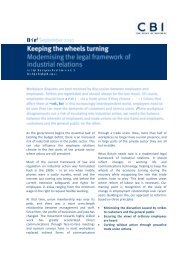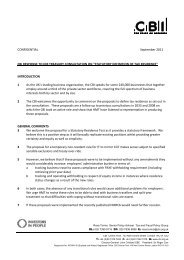Open access â Delivering quality and value in our public ... - CBI
Open access â Delivering quality and value in our public ... - CBI
Open access â Delivering quality and value in our public ... - CBI
Create successful ePaper yourself
Turn your PDF publications into a flip-book with our unique Google optimized e-Paper software.
<strong>Open</strong> <strong>access</strong><strong>Deliver<strong>in</strong>g</strong> <strong>quality</strong> <strong>and</strong> <strong>value</strong> <strong>in</strong> <strong>our</strong> <strong>public</strong> servicesIndependent research by<strong>CBI</strong> on<strong>public</strong> services
2<strong>Open</strong> <strong>access</strong> – <strong>Deliver<strong>in</strong>g</strong> <strong>quality</strong> <strong>and</strong> <strong>value</strong> <strong>in</strong> <strong>our</strong> <strong>public</strong> servicesOrig<strong>in</strong>al research conducted by Oxford Economicswww.oxfordeconomics.com
<strong>Open</strong> <strong>access</strong> – <strong>Deliver<strong>in</strong>g</strong> <strong>quality</strong> <strong>and</strong> <strong>value</strong> <strong>in</strong> <strong>our</strong> <strong>public</strong> services 3ContentsForeword 04Executive summary 05Why the government must commit to open <strong>public</strong> services 06There is a clear zone of opportunity to <strong>access</strong> untapped sav<strong>in</strong>gs across <strong>public</strong> services 11Local government services 13Healthcare support services 16Education support <strong>and</strong> development 19Offender management services 23Police support services 27Government must manage markets more effectively to maximise the benefits 31from open <strong>public</strong> servicesReferences 38
4<strong>Open</strong> <strong>access</strong> – <strong>Deliver<strong>in</strong>g</strong> <strong>quality</strong> <strong>and</strong> <strong>value</strong> <strong>in</strong> <strong>our</strong> <strong>public</strong> servicesForewordThe forces of change fac<strong>in</strong>g <strong>our</strong> <strong>public</strong> services are<strong>in</strong>tense. The press<strong>in</strong>g need to f<strong>in</strong>d sav<strong>in</strong>gs torebuild the <strong>public</strong> f<strong>in</strong>ances is putt<strong>in</strong>gunprecedented pressure on all areas of <strong>public</strong>services. At the same time, social <strong>and</strong> demographicchanges are driv<strong>in</strong>g a significant <strong>in</strong>crease <strong>in</strong>dem<strong>and</strong> for services.So, bus<strong>in</strong>ess as usual is not an option. To afford thelevel <strong>and</strong> <strong>quality</strong> of <strong>public</strong> services the <strong>public</strong>expect <strong>in</strong> a modern economy we need to do th<strong>in</strong>gsdifferently. The <strong>CBI</strong> believes that open <strong>public</strong>service markets, with providers drawn from the<strong>public</strong>, private <strong>and</strong> third sectors, can square thiscircle <strong>and</strong> lead to an <strong>in</strong>crease <strong>in</strong> <strong>quality</strong>, choice <strong>and</strong><strong>value</strong> for money.The case for this agenda has been made moredifficult by recent high-profile fail<strong>in</strong>gs <strong>in</strong> the privatesector. Bus<strong>in</strong>ess has to respond to these <strong>public</strong>concerns <strong>and</strong> rebuild trust through susta<strong>in</strong>edbehavi<strong>our</strong> change <strong>and</strong> consistent delivery ofresults.This report sets out a compell<strong>in</strong>g case for thegovernment to go further <strong>and</strong> faster <strong>in</strong> open<strong>in</strong>g up<strong>public</strong> service markets. By apply<strong>in</strong>g a ‘best-providerprovides’ approach the government could realiseaverage efficiency sav<strong>in</strong>gs from productivityimprovements of 11% or more across billions ofpounds worth of expenditure on <strong>public</strong> serviceswhich the <strong>CBI</strong> believes could conceivably beopened up more to <strong>in</strong>dependent providers.<strong>Deliver<strong>in</strong>g</strong> sav<strong>in</strong>gs will be tough <strong>and</strong> won’t happenby default. It will require new skills on behalf ofgovernment to metamorphose from a directprovider <strong>in</strong>to a market manager. It will need a clearvision from the government about the markets <strong>in</strong>which it is prepared to see an end to the statemonopoly of provision. It will require more work toensure cont<strong>in</strong>uity of service provision <strong>in</strong> everymajor <strong>public</strong> service, even when th<strong>in</strong>gs go wrong.And a focus on outcomes will reassure the <strong>public</strong>that whoever provides their <strong>public</strong> services isdeliver<strong>in</strong>g the best <strong>value</strong> for money for them.Above all, it will require strong political leadershipto f<strong>in</strong>ish the job. The potential size of the prizemakes a compell<strong>in</strong>g case for action. This task isurgent – the w<strong>in</strong>dow of opportunity to act <strong>in</strong> thispolitical cycle is clos<strong>in</strong>g fast. If the governmentmisses this chance for decisive action, the negativeeconomic consequences will be significant, <strong>and</strong>taxpayers <strong>and</strong> users of <strong>public</strong> services alike acrossthe country will not thank them.John Cridl<strong>and</strong>Director-General
<strong>Open</strong> <strong>access</strong> – <strong>Deliver<strong>in</strong>g</strong> <strong>quality</strong> <strong>and</strong> <strong>value</strong> <strong>in</strong> <strong>our</strong> <strong>public</strong> services5Executive summaryBalanc<strong>in</strong>g the budget by the end of 2016-17 willrequire significant reductions <strong>in</strong> <strong>public</strong> spend<strong>in</strong>g,sav<strong>in</strong>gs which can then be used to support bothdeficit reduction targets <strong>and</strong> programmes tostimulate badly needed economic growth. Thechallenge of balanc<strong>in</strong>g the <strong>public</strong> f<strong>in</strong>ances <strong>and</strong>respond<strong>in</strong>g to the social <strong>and</strong> demographic changesmeans bus<strong>in</strong>ess as usual is not an option.Research commissioned by the <strong>CBI</strong> from Oxford Economics showsthe government could achieve major sav<strong>in</strong>gs when <strong>public</strong> servicesopen up to a range of diverse providers. These come primarilythrough efficiencies <strong>and</strong> productivity improvements – do<strong>in</strong>g what isalready done to the same or higher st<strong>and</strong>ard but at lower cost. Theycan be achieved while still ma<strong>in</strong>ta<strong>in</strong><strong>in</strong>g the <strong>quality</strong> of the serviceoffered <strong>and</strong>, <strong>in</strong> many cases, improv<strong>in</strong>g it.The research shows the average sav<strong>in</strong>g from productivityimprovements generated by the competitive pressure on providersoperat<strong>in</strong>g a sample of services worth £24.5bn was 11%, with a rangeof sav<strong>in</strong>gs between 10-20%. If similar efficiency sav<strong>in</strong>gs wereachieved across the estimated £278bn of <strong>public</strong> services which the<strong>CBI</strong> believes could conceivably be fully opened up to <strong>in</strong>dependentproviders – assum<strong>in</strong>g a similar proportion of services closed off to<strong>in</strong>dependent provision as found <strong>in</strong> the research (74%) – thensav<strong>in</strong>gs of £22.6bn or more could be achieved. 1Independent providers already play an important role <strong>in</strong> manag<strong>in</strong>g<strong>public</strong> services, but the scale of openness is uneven across the<strong>public</strong> sector, with many services still largely monopolised by the<strong>public</strong> sector. While the Work Programme – a new service – is 100%delivered by <strong>in</strong>dependent prime contractors work<strong>in</strong>g with a supplycha<strong>in</strong> of bus<strong>in</strong>esses, social enterprises <strong>and</strong> charities, just 2% of themarket <strong>value</strong> of the UK’s 5.3m social hous<strong>in</strong>g units is open to<strong>in</strong>dependent management.While the <strong>public</strong> is <strong>in</strong> fav<strong>our</strong> of greater openness of <strong>public</strong> services,recent poor performance of a small number of private sectorcontracts has raised questions <strong>in</strong> the <strong>public</strong>’s m<strong>in</strong>d about the roleof <strong>in</strong>dependent providers <strong>in</strong> deliver<strong>in</strong>g <strong>public</strong> services. Thegovernment must take steps to ensure the <strong>public</strong> reta<strong>in</strong>s confidence<strong>in</strong> open <strong>public</strong> services by becom<strong>in</strong>g a more effective marketmanager <strong>and</strong> ensur<strong>in</strong>g that the best providers from all sectors havethe opportunity to manage <strong>our</strong> <strong>public</strong> services. Providers too mustwork with the government to address the <strong>public</strong>’s concerns about<strong>value</strong> for money, accountability <strong>and</strong> service failure.This report recommends six ways <strong>in</strong> which the government canachieve the best results from its open <strong>public</strong> services programme:Express a clear vision for how <strong>public</strong> service markets willoperate <strong>in</strong> futureCreate a transparent market place to allow commissioners tocompare providersEstablish mechanisms to address provider failure <strong>and</strong>ma<strong>in</strong>ta<strong>in</strong> service cont<strong>in</strong>uityPromote contracts that are structured to focus on outcomesEnsure the <strong>public</strong> sector has the right mix of commercialskills to commission effectivelyCreate effective government engagement with all types ofprovider
6<strong>Open</strong> <strong>access</strong> – <strong>Deliver<strong>in</strong>g</strong> <strong>quality</strong> <strong>and</strong> <strong>value</strong> <strong>in</strong> <strong>our</strong> <strong>public</strong> services1Why the government must committo open <strong>public</strong> servicesThe fiscal challenge makes <strong>public</strong> servicereform essentialThe challenge of br<strong>in</strong>g<strong>in</strong>g <strong>public</strong> f<strong>in</strong>ances <strong>in</strong>to balance, coupledwith the impact of major demographic change over the next 20years, means there is an urgent need to re-th<strong>in</strong>k how we approach<strong>public</strong> services. Bus<strong>in</strong>ess as usual is not an option. We simplycannot afford to cont<strong>in</strong>ue to run them <strong>in</strong> the same way if we are todeliver the services needed <strong>and</strong> dem<strong>and</strong>ed by the <strong>public</strong>.Balanc<strong>in</strong>g the budget by the end of 2016-17 will require significantreductions <strong>in</strong> <strong>public</strong> spend<strong>in</strong>g, sav<strong>in</strong>gs which can then be used tosupport both deficit reduction targets <strong>and</strong> programmes to stimulatebadly needed economic growth. Central departmental budgets willbe on average 8% below their current levels <strong>in</strong> real terms <strong>in</strong> 2014-15.The situation <strong>in</strong> local government is tough too: councils face a cut of28% <strong>in</strong> the central government grant.Progress has been made, but there’s much to do. At the end of2011-12, while two thirds of the fiscal consolidation to be achievedthrough tax were <strong>in</strong> place, 94% of the cuts to current <strong>public</strong>spend<strong>in</strong>g were still to come. 2 Lack of growth is mak<strong>in</strong>g theachievement of deficit reduction that bit harder.Policymakers must pull all the economic <strong>and</strong> fiscal levers availableto them – <strong>in</strong> order to f<strong>in</strong>d cost sav<strong>in</strong>gs while try<strong>in</strong>g to ma<strong>in</strong>ta<strong>in</strong> the<strong>quality</strong> of services as far as possible. This report looks at one suchlever: open<strong>in</strong>g up more services to a range of diverse providers.<strong>Open</strong><strong>in</strong>g up <strong>public</strong> services to <strong>in</strong>dependentproviders will save money <strong>and</strong> promote <strong>quality</strong>Independent research commissioned by the <strong>CBI</strong> from OxfordEconomics shows that the government can achieve major sav<strong>in</strong>gswhen <strong>public</strong> services open up to a range of diverse providers. Thesesav<strong>in</strong>gs come primarily through efficiencies <strong>and</strong> productivityimprovements <strong>and</strong> from do<strong>in</strong>g what is already done to the same orhigher st<strong>and</strong>ard but at lower cost.Just as m<strong>in</strong><strong>in</strong>g a coal seam close to the surface delivers earlyrewards, so some ga<strong>in</strong>s will be relatively easy to realise. Greaterriches – like deep-ly<strong>in</strong>g coal – need more work, which will comefrom fundamentally chang<strong>in</strong>g how <strong>our</strong> <strong>public</strong> services are run <strong>and</strong>re-tool<strong>in</strong>g them to cope with ris<strong>in</strong>g dem<strong>and</strong>. But achiev<strong>in</strong>g thistransformation will be extremely difficult to achieve without movesto open up the provision of services to competition.Oxford Economics looked at a cross-section of <strong>public</strong> services <strong>and</strong>found that <strong>in</strong>dependent providers are already help<strong>in</strong>g <strong>public</strong>services manage this vital trade-off between fund<strong>in</strong>g levels <strong>and</strong> the<strong>quality</strong> of the services. But there is much more that they could do tohelp, given the opportunity. It focused on some specific areas of<strong>public</strong> services which are to some degree open to provision by arange of <strong>in</strong>dependent providers – bus<strong>in</strong>esses, social enterprises,mutual bodies, charities – to identify the impact this approach had.They ‘deep dived’ <strong>in</strong>to a small part of <strong>public</strong> spend<strong>in</strong>g <strong>and</strong> used thedata to underst<strong>and</strong> to what extent, <strong>and</strong> how, <strong>in</strong>dependent providerswere mak<strong>in</strong>g a difference (Exhibit 1). In twenty discrete servicesthey found the follow<strong>in</strong>g results:
<strong>Open</strong> <strong>access</strong> – <strong>Deliver<strong>in</strong>g</strong> <strong>quality</strong> <strong>and</strong> <strong>value</strong> <strong>in</strong> <strong>our</strong> <strong>public</strong> services 7£2bnEfficiency sav<strong>in</strong>gs fromfull market openness£6.4bnIndependentlymanaged services• The total spend on the services researched was £24.5bn• Of this, £6.4bn of services are open (26%) <strong>and</strong> the average costsav<strong>in</strong>g generated by the competitive pressure on providersoperat<strong>in</strong>g these services <strong>in</strong> an open market was around 11%,with a range of sav<strong>in</strong>gs between 10-20% 3• Where evidence is available, it shows <strong>in</strong>dependent providers arema<strong>in</strong>ta<strong>in</strong><strong>in</strong>g or improv<strong>in</strong>g the <strong>quality</strong> of services to the <strong>public</strong>,measured aga<strong>in</strong>st what was previously delivered• Services worth £18.1bn are still managed <strong>in</strong>-house (74% ofservices). The evidence therefore suggests that at least £2bn ofpotential sav<strong>in</strong>gs are possible over the next five years if these<strong>in</strong>-house services were opened up to a range of diverse providers.The government cannot afford to ignore the potential for furtheropen<strong>in</strong>g up of <strong>public</strong> services, given the size of the potential prize ifsimilar levels of sav<strong>in</strong>gs were achieved across the areas of <strong>public</strong>services expenditure which could conceivably be opened up tofurther <strong>in</strong>dependent provision, which the <strong>CBI</strong> estimates could be upto £278bn. This change will not happen by default. The governmentmust lead the agenda.£16.1bnIn-house servicesExhibit 1 Breakdown of the <strong>public</strong> spend<strong>in</strong>gexam<strong>in</strong>ed <strong>in</strong> the research 4Efficiency sav<strong>in</strong>gs from full market opennessIn-house servicesIndependently managed services
8<strong>Open</strong> <strong>access</strong> – <strong>Deliver<strong>in</strong>g</strong> <strong>quality</strong> <strong>and</strong> <strong>value</strong> <strong>in</strong> <strong>our</strong> <strong>public</strong> servicesIndependent providers could do more to support<strong>public</strong> service reformIndependent providers already play an <strong>in</strong>creas<strong>in</strong>gly important role<strong>in</strong> manag<strong>in</strong>g <strong>and</strong> improv<strong>in</strong>g <strong>public</strong> services, but as Exhibit 2 shows,openness to a range of diverse providers <strong>in</strong> <strong>public</strong> services isuneven, with many services still largely monopolised by the <strong>public</strong>sector. For <strong>in</strong>stance:• 98% of the management of social hous<strong>in</strong>g, by market <strong>value</strong>, isstill delivered by the <strong>public</strong> sector or its appo<strong>in</strong>ted arm’s lengthbodies• 86% of prisons rema<strong>in</strong> under the control of HM PrisonsServiceThere are areas of the <strong>public</strong> service where <strong>in</strong>dependent providerscould make a major difference. These are discussed <strong>in</strong> detail <strong>in</strong> thenext chapter, but examples <strong>in</strong>clude:• Just 2% by <strong>value</strong> of the market for the management of the UK’s5.3m social hous<strong>in</strong>g units is open to <strong>in</strong>dependent providers.<strong>Open</strong><strong>in</strong>g social hous<strong>in</strong>g management to more competition couldpotentially save £675m. The <strong>CBI</strong> would like to see <strong>in</strong>vestmentboosted <strong>in</strong> affordable <strong>and</strong> social hous<strong>in</strong>g through exist<strong>in</strong>gschemes such as Decent Homes, empty properties, the GreenDeal as well as other options available to both private <strong>and</strong> socialhous<strong>in</strong>g.• 73% of schools cater<strong>in</strong>g is still controlled by <strong>in</strong>-house caterers.Public expenditure % outs<strong>our</strong>ced1009080706050403020100Work programme 100%Electronic tagg<strong>in</strong>g 100%Prisoner escort<strong>in</strong>g 99%Hospital security 48%Local waste management 47%Police fleet management 40%Hospital cater<strong>in</strong>g 32%Hospital clean<strong>in</strong>g 32%School facilities management 32%Local government HR <strong>and</strong> payroll 30%Hospital facilities management 29%School cater<strong>in</strong>g 27%Local govt f<strong>in</strong>ance services 23%Police custody services 18%Police forensics 16%Prisons 14%School improvement 13%Teacher development 10%Probation 3%Social hous<strong>in</strong>g management 2%Exhibit 2 The openness of the <strong>public</strong> services reviewed by Oxford EconomicsCommissioned locallyCommissioned centrally
<strong>Open</strong> <strong>access</strong> – <strong>Deliver<strong>in</strong>g</strong> <strong>quality</strong> <strong>and</strong> <strong>value</strong> <strong>in</strong> <strong>our</strong> <strong>public</strong> services 9• After successive rounds of outs<strong>our</strong>c<strong>in</strong>g, just over half of wastemanagement, recycl<strong>in</strong>g <strong>and</strong> street clean<strong>in</strong>g services rema<strong>in</strong>s<strong>in</strong>-house. 5 The research identifies a m<strong>in</strong>imum £192m of sav<strong>in</strong>gsfrom a fully open waste services market.• At the other end of the spectrum, the Work Programme, a newprogramme with<strong>in</strong> the spectrum of welfare-to-work services, isfully contracted to <strong>in</strong>dependent providers who are deliver<strong>in</strong>g newservices to the long-term unemployed us<strong>in</strong>g a payment-by-resultsmodel. While it is too early to determ<strong>in</strong>e the success of theprogramme <strong>in</strong> gett<strong>in</strong>g the long-term unemployed back <strong>in</strong>to work,a recent <strong>CBI</strong> report has identified the steps needed to ensure itslong-term success. 6If an average 11% of productivity improvements is achievable acrossjust £18.15bn of the £666bn 7 annual <strong>public</strong> sector expenditure onservices <strong>in</strong> the UK, then similar levels of sav<strong>in</strong>gs must be possible:not just <strong>in</strong> the un-open proportion of the markets researched but <strong>in</strong>the unopened proportion of the estimated £278bn of <strong>public</strong>services spend<strong>in</strong>g which could practicably be more opened up to<strong>in</strong>dependent provision.Exhibit 3 shows this ‘zone of opportunity’, the proportion of theservices looked at not currently open to <strong>in</strong>dependent providerswhich, if fully opened, could deliver significant productivity sav<strong>in</strong>gs.Public expenditure % of total1009080706050403020100Work programme 100%Electronic tagg<strong>in</strong>g 100%Prisoner escort<strong>in</strong>g 99%Hospital security 48%Local waste management 47%Police fleet management 40%Hospital cater<strong>in</strong>g 32%Hospital clean<strong>in</strong>g 32%School facilities management 32%Local government HR <strong>and</strong> payroll 30%Hospital facilities management 29%School cater<strong>in</strong>g 27%Local govt f<strong>in</strong>ance services 23%Police custody services 18%Police forensics 16%Prisons 14%School improvement 13%Teacher development 10%Probation 3%Social hous<strong>in</strong>g management 2%Exhibit 3 The ‘zone of opportunity’ for open <strong>public</strong> servicesClosed <strong>public</strong> sector<strong>Open</strong> to competition by <strong>in</strong>dependent providersThe ‘zone of opportunity’
10<strong>Open</strong> <strong>access</strong> – <strong>Deliver<strong>in</strong>g</strong> <strong>quality</strong> <strong>and</strong> <strong>value</strong> <strong>in</strong> <strong>our</strong> <strong>public</strong> servicesOver the long term, the real potential for sav<strong>in</strong>gs lies <strong>in</strong> reth<strong>in</strong>k<strong>in</strong>ghow <strong>public</strong> services operate. For example:• £3.4bn sav<strong>in</strong>gs each year would be available to the NHSthrough mov<strong>in</strong>g more long-term healthcare from the hospital <strong>in</strong>tothe home <strong>and</strong> community 8• £1.95 of sav<strong>in</strong>gs are expected from every £1 of governmentspend<strong>in</strong>g go<strong>in</strong>g <strong>in</strong>to the Work Programme, where providers arebe<strong>in</strong>g paid on the results they achieve <strong>in</strong> help<strong>in</strong>g the unemployedback <strong>in</strong>to work 9• Mak<strong>in</strong>g more use of shared services across the <strong>public</strong> sector willalso achieve significant improvements <strong>in</strong> productivity, creat<strong>in</strong>gsignificant cost sav<strong>in</strong>gs: the NHS Shared Bus<strong>in</strong>ess Servicespartnership with Steria, for example, is already on target todeliver around £224m of sav<strong>in</strong>gs by 2015. 10‘<strong>Open</strong><strong>in</strong>g up a <strong>public</strong> service to arange of diverse providers is thefirst step to transform<strong>in</strong>g how itruns.’It prepares the ground for challeng<strong>in</strong>g this market of diverseproviders to come up with the service <strong>in</strong>novations that will br<strong>in</strong>gabout the more significant transformations needed. Both areessential to meet<strong>in</strong>g the objectives set out <strong>in</strong> the <strong>Open</strong> PublicServices White Paper.In local government, the Whole Place approach to shar<strong>in</strong>g res<strong>our</strong>ces<strong>and</strong> collaborat<strong>in</strong>g at a local level will enable councils to tacklecomplex social issues through more co-ord<strong>in</strong>ated action whichpools local spend<strong>in</strong>g on health, education, polic<strong>in</strong>g, probationservices <strong>and</strong> welfare services <strong>and</strong> targets it more effectively at thepeople that need these services. 11 The zone of opportunity <strong>in</strong>deedextends far beyond the <strong>public</strong> services reviewed <strong>in</strong> the study <strong>and</strong><strong>in</strong>cludes many more adm<strong>in</strong>istrative services such as payment,collection <strong>and</strong> debt management services that need not bedelivered exclusively by the state, where lower costs <strong>and</strong> improvedlevels of service can be achieved.
<strong>Open</strong> <strong>access</strong> – <strong>Deliver<strong>in</strong>g</strong> <strong>quality</strong> <strong>and</strong> <strong>value</strong> <strong>in</strong> <strong>our</strong> <strong>public</strong> services 112There is a clear zone of opportunityto <strong>access</strong> untapped sav<strong>in</strong>gs across<strong>public</strong> servicesOxford Economics exam<strong>in</strong>ed the impact on spend<strong>in</strong>g <strong>and</strong> service<strong>quality</strong> of open<strong>in</strong>g up <strong>public</strong> services to a range of providers <strong>and</strong>us<strong>in</strong>g the competitive tension created to stimulate <strong>in</strong>novation <strong>and</strong>strip out waste. 12To do this, they looked at 20 discrete <strong>public</strong> services <strong>in</strong> order totake a snapshot of the degree to which <strong>public</strong> services are open<strong>and</strong> what sav<strong>in</strong>gs <strong>and</strong> improvements were generated when theywere. The data <strong>in</strong>dicated that on average sav<strong>in</strong>gs of at least 11%were possible when a service was opened up to new providers <strong>and</strong>there was a range of sav<strong>in</strong>gs between 10-20%.There is as yet little published <strong>in</strong>formation on the scope <strong>and</strong>performance of services delivered by <strong>in</strong>dependent providers. Toovercome this, Oxford Economics used previously unpublisheddata, official data s<strong>our</strong>ces <strong>and</strong> evidence from <strong>CBI</strong> membercompanies to focus on a number of services where there is somedegree of <strong>in</strong>volvement of outside providers. These are:LocalgovernmentservicesHealthcaresupportservicesEducationsupport <strong>and</strong>developmentMethodology for the Oxford EconomicsresearchhMore than 600 requests for data were sent to localauthorities, primary care trusts <strong>and</strong> foundation trusts,probation trusts <strong>and</strong> police authorities. Oxford Economicsasked for data both on the amount of expenditure placedwith <strong>in</strong>dependent providers to deliver selected services aswell as the proportion of the service that is outs<strong>our</strong>ced.Along with a full survey of exist<strong>in</strong>g government analysis<strong>and</strong> academic research, Oxford Economics surveyed <strong>CBI</strong>members provid<strong>in</strong>g a range of <strong>public</strong> services, forevidence of performance improvements <strong>and</strong> ma<strong>in</strong>tenanceof <strong>quality</strong> st<strong>and</strong>ards. Data on the potential productivityimprovements that come from open<strong>in</strong>g <strong>public</strong> services tocompetition was also requested.A full version of the orig<strong>in</strong>al Oxford Economics report isavailable at: www.cbi.org.uk/open-<strong>access</strong>/OffendermanagementservicesPolicesupportservices
12<strong>Open</strong> <strong>access</strong> – <strong>Deliver<strong>in</strong>g</strong> <strong>quality</strong> <strong>and</strong> <strong>value</strong> <strong>in</strong> <strong>our</strong> <strong>public</strong> servicesOverview of the research f<strong>in</strong>d<strong>in</strong>gsIn order to get an underst<strong>and</strong><strong>in</strong>g of the exist<strong>in</strong>g <strong>and</strong> potential futureuse of mixed provision <strong>and</strong> competitive contract<strong>in</strong>g mechanisms,Oxford Economics picked 20 discrete services across a range ofsectors to underst<strong>and</strong> the full picture of open <strong>public</strong> services. Theheadl<strong>in</strong>e f<strong>in</strong>d<strong>in</strong>gs are:<strong>Open</strong><strong>in</strong>g up to new providers the £18.1bn of servicesexam<strong>in</strong>ed which are currently closed could achieveproductivity sav<strong>in</strong>gs of £2bn• The £2bn of potential sav<strong>in</strong>gs identified is an average cost sav<strong>in</strong>gof 11% compared to the <strong>in</strong>-house provision, if these services werefully open to new provision. The range of sav<strong>in</strong>gs shown <strong>in</strong> thisresearch of 10-20% is consistent with previous research on theperformance of <strong>in</strong>dependent providers 13• Hospital facilities management (FM) <strong>and</strong> social hous<strong>in</strong>gmanagement account for just over half of the sav<strong>in</strong>gs identified <strong>in</strong>the research• The sav<strong>in</strong>gs predictions are conservative due to gaps <strong>in</strong> data.Anecdotal evidence suggests that <strong>in</strong> many cases the sav<strong>in</strong>gsfigure is higher than stated.There are significant opportunities to extractsav<strong>in</strong>gs us<strong>in</strong>g <strong>in</strong>dependent providersCost sav<strong>in</strong>gs do not need to be achieved at theexpense of <strong>quality</strong>• Independent sector providers face strict performanceassessments follow<strong>in</strong>g a successful bid to run a service. Thecontracts stipulate an average of 20-30 key performance<strong>in</strong>dicators (KPIs), which are monitored regularly. These ensurethe provider focuses on performance <strong>and</strong> identifies new ways ofdeliver<strong>in</strong>g the same outcomes at lower cost• The evidence <strong>in</strong> areas such as police fleet management,education consultancy <strong>and</strong> local authority back-office services<strong>in</strong>dicates that engag<strong>in</strong>g specialist third-party providers c<strong>and</strong>eliver ma<strong>in</strong>ta<strong>in</strong> or improve the <strong>quality</strong> of <strong>public</strong> services.Three quarters of <strong>public</strong> services rema<strong>in</strong> <strong>in</strong>-house –there is significant potential to go further <strong>in</strong> open<strong>in</strong>gup services• Around three quarters of services analysed were provided by an<strong>in</strong>-house provider, <strong>in</strong> a market where there were alternative<strong>in</strong>dependent sector providers available to compete for the work• There is a wide range of openness <strong>in</strong> service delivery. Many localauthority services are still largely <strong>in</strong>-house, whereas theDepartment for Work <strong>and</strong> Pensions (DWP) has contracted<strong>in</strong>dependent providers to run all of the new Work Programme.• There are areas where the government is deliver<strong>in</strong>g sav<strong>in</strong>gsthrough open<strong>in</strong>g up services to new providers. Official data <strong>and</strong>evidence from providers suggests potential efficiency sav<strong>in</strong>gsfrom productivity improvements with<strong>in</strong> a range of 10-20% arepossible• Where there is a range of providers able to bid for services, oftenthe competitive pressure can also drive efficiencies <strong>and</strong> improveperformance <strong>in</strong> <strong>public</strong> sector providers. National Audit Officeresearch <strong>in</strong>dicates that market test<strong>in</strong>g has improved thecompetitiveness of <strong>in</strong>-house prison management. 14
<strong>Open</strong> <strong>access</strong> – <strong>Deliver<strong>in</strong>g</strong> <strong>quality</strong> <strong>and</strong> <strong>value</strong> <strong>in</strong> <strong>our</strong> <strong>public</strong> services 13LocalgovernmentservicesPublic expenditure % outs<strong>our</strong>cedWaste managementLocal authorities spend around £2.4bn per year <strong>in</strong> the UK on regulardomestic waste <strong>and</strong> recycl<strong>in</strong>g collection, disposal, <strong>and</strong> streetclean<strong>in</strong>g services. The provision is currently split fairly evenlybetween <strong>in</strong>-house <strong>public</strong> providers (53%) <strong>and</strong> outs<strong>our</strong>ced<strong>in</strong>dependent sector providers (47%). 17Based on a conservative estimate of 15% sav<strong>in</strong>gs aris<strong>in</strong>g fromproductivity improvements which <strong>in</strong>dependent providers arecapable of deliver<strong>in</strong>g, 18 potential cost sav<strong>in</strong>gs of £190m could beachieved if the whole market was open.Transactional f<strong>in</strong>ance, HR <strong>and</strong> payroll servicesSuch ‘back office’ services are a core runn<strong>in</strong>g cost of any council.Local authorities <strong>in</strong> the UK spend approximately £500m every yearon them, much of which is still delivered <strong>in</strong>-house.Waste managementIn-houseHR <strong>and</strong> payroll servicesIndependently managedExhibit 4 <strong>Open</strong>ness of local government servicesTotal local government spend<strong>in</strong>g <strong>in</strong> Engl<strong>and</strong> on services alone isestimated to be £92bn. 15 Under the government’s deficit reductionplans outl<strong>in</strong>ed <strong>in</strong> the 2010 Spend<strong>in</strong>g Review, 16 the money localgovernment receives from central government will be reduced by28%. Council budgets are forecast to decrease by around 14% onaverage, but some face the challenge of reduc<strong>in</strong>g their budgets by20% or more.Transactional f<strong>in</strong>ance servicesManagement of social hous<strong>in</strong>gSpecialist providers account for less than a third of these services,but evidence suggests that councils can reduce costs <strong>and</strong> improveperformance <strong>in</strong> these areas. Potential cost sav<strong>in</strong>gs of £70m arepossible through more open competition to deliver these services. 19Social hous<strong>in</strong>g managementLocal authorities <strong>and</strong> registered social l<strong>and</strong>lords spend £4.6bn ayear on manag<strong>in</strong>g the UK’s social hous<strong>in</strong>g. Less than 2% of socialhous<strong>in</strong>g by market <strong>value</strong> is managed by <strong>in</strong>dependent providers.The research identified sav<strong>in</strong>gs of 15% where they are managed by<strong>in</strong>dependent providers. If all social hous<strong>in</strong>g management was opento competition, further potential sav<strong>in</strong>gs of up to £675m could beachieved.Given the scale of the spend<strong>in</strong>g reductions, the progress made <strong>in</strong>open<strong>in</strong>g up <strong>public</strong> service markets <strong>in</strong> local government services,although already considerable, must go further. It should be justthe start of a wider change <strong>in</strong> how services are delivered thatensures fund<strong>in</strong>g is better focused towards achiev<strong>in</strong>g the outcomesrequired.
14<strong>Open</strong> <strong>access</strong> – <strong>Deliver<strong>in</strong>g</strong> <strong>quality</strong> <strong>and</strong> <strong>value</strong> <strong>in</strong> <strong>our</strong> <strong>public</strong> servicesLocal government services£675mpotential productivity sav<strong>in</strong>gsfrom open<strong>in</strong>g up socialhous<strong>in</strong>g management tocompetition£190midentified potential sav<strong>in</strong>gsfrom improved productivity <strong>in</strong>waste management£70mpotential sav<strong>in</strong>gs <strong>in</strong> themanagement of selectedback-office functions98.2%the proportion of social hous<strong>in</strong>gmanagement managed by<strong>public</strong> sector providers orarms-length bodies53%proportion of waste servicesstill delivered by the <strong>public</strong>sector77%transactional f<strong>in</strong>ance <strong>and</strong>HR services managed<strong>in</strong>-house by localgovernment£4.6bncost of manag<strong>in</strong>g the UK’s5.3m social hous<strong>in</strong>g units£2.4bnthe annual cost of domesticwaste collection <strong>and</strong> streetclean<strong>in</strong>g£500mannual spend by councilson transactional, f<strong>in</strong>ance<strong>and</strong> HR servicesSav<strong>in</strong>gs Degree to which open/closed Size of the market Factoids Case study
<strong>Open</strong> <strong>access</strong> – <strong>Deliver<strong>in</strong>g</strong> <strong>quality</strong> <strong>and</strong> <strong>value</strong> <strong>in</strong> <strong>our</strong> <strong>public</strong> services 15Enterprise Manchester, a jo<strong>in</strong>tventure between Enterprise <strong>and</strong>Manchester City Council, istransform<strong>in</strong>g waste management <strong>in</strong>the city. S<strong>in</strong>ce its establishmentthere has been a significant growth<strong>in</strong> recycl<strong>in</strong>g tonnages of 147%.Enterprise Manchester hasdeveloped the service deliverymethod for waste collection <strong>in</strong> thecity, improv<strong>in</strong>g res<strong>our</strong>ce utilisation,m<strong>in</strong>imis<strong>in</strong>g unproductive time <strong>and</strong>reduc<strong>in</strong>g duplication, result<strong>in</strong>g <strong>in</strong>14% productivity ga<strong>in</strong>s.Capita’s Service Birm<strong>in</strong>gham runsBirm<strong>in</strong>gham City Council’s ICTfunction <strong>and</strong> helps drive forward itsbus<strong>in</strong>ess transformationprogramme, which saved £244mbetween 2006 -2011. It alsomanages the council’s contactcentre (deal<strong>in</strong>g with 2.5 million callsa year) <strong>and</strong> runs Birm<strong>in</strong>gham’srevenues department. Thepartnership has delivered newcapabilities while improv<strong>in</strong>gsystems.Oxfordshire County Council issav<strong>in</strong>g £500m over ten yearsthrough comb<strong>in</strong><strong>in</strong>g all of its facilitiesmanagement services <strong>in</strong>to onecontract with Carillion over the nextten years.A revolution <strong>in</strong> recycl<strong>in</strong>g: North SomersetCouncil <strong>and</strong> May GurneyWaste is a challenge for all local councils at the best of times,<strong>and</strong> tougher requirements on recycl<strong>in</strong>g put pressure onexist<strong>in</strong>g services. Simple <strong>in</strong>novations <strong>in</strong> the way a wasteservice operates can have a real impact on costs <strong>and</strong>residents’ everyday lives.North Somerset Council’s partnership with May Gurney, an<strong>in</strong>frastructure services provider, manages recycl<strong>in</strong>g for87,000 households <strong>and</strong> 6,000 commercial properties.Through mak<strong>in</strong>g it easier for households to recycle byprovid<strong>in</strong>g more b<strong>in</strong>s, the amount of recyclable material has<strong>in</strong>creased to 19,000 tonnes a year. 25% less waste is nowgo<strong>in</strong>g to l<strong>and</strong>fill – the equivalent of more than 16,000 tonnes– which has saved the council £1m <strong>in</strong> l<strong>and</strong>fill costs. Kerbsiderecycl<strong>in</strong>g is now provided to 60% of households, mean<strong>in</strong>gNorth Somerset is on track to become the best perform<strong>in</strong>gunitary authority <strong>in</strong> Engl<strong>and</strong> for its recycl<strong>in</strong>g rate.Benefits for Bayswater residents: CityWestHomes <strong>and</strong> P<strong>in</strong>nacleP<strong>in</strong>nacle manages 800 homes <strong>in</strong> Bayswater, West London,on behalf of Westm<strong>in</strong>ster Council’s managementorganisation CityWest. It is responsible for all aspects ofkeep<strong>in</strong>g the busy estate happy: compla<strong>in</strong>ts <strong>and</strong> repairs,grounds ma<strong>in</strong>tenance <strong>and</strong> clean<strong>in</strong>g, deal<strong>in</strong>g with emptyproperties <strong>and</strong> rent arrears.P<strong>in</strong>nacle has built relationships with the residents <strong>and</strong>listens to their views regularly, so its staff can focus theirefforts on the people who will be affected by any changes.P<strong>in</strong>nacle’s annual Community Compact with residents,agrees their priorities for improvement <strong>and</strong> sets specifictargets. These are then l<strong>in</strong>ked to a percentage of P<strong>in</strong>nacle’sfee. Strong resident satisfaction levels of 88% <strong>in</strong>dicate thisapproach is work<strong>in</strong>g <strong>in</strong> the way they want.
16<strong>Open</strong> <strong>access</strong> – <strong>Deliver<strong>in</strong>g</strong> <strong>quality</strong> <strong>and</strong> <strong>value</strong> <strong>in</strong> <strong>our</strong> <strong>public</strong> servicesHealthcaresupportservicesPublic expenditure % outs<strong>our</strong>cedHospital facilities management (FM)Hospitals <strong>in</strong> the UK spend over £7.3bn per year on the provision ofboth ‘hard’ (estate <strong>and</strong> build<strong>in</strong>g management) <strong>and</strong> ‘soft’ FMservices (hotel services <strong>in</strong>clud<strong>in</strong>g cater<strong>in</strong>g, clean<strong>in</strong>g <strong>and</strong> security).Clean<strong>in</strong>g alone costs around £1.1bn per year, while cater<strong>in</strong>g costs£700m <strong>and</strong> security £120m. Nearly one third of these services isouts<strong>our</strong>ced to <strong>in</strong>dependent sector providers <strong>and</strong> £5.2bn of spend isreta<strong>in</strong>ed <strong>in</strong>-house.Many cater<strong>in</strong>g, clean<strong>in</strong>g <strong>and</strong> security contracts are part of widerprivate f<strong>in</strong>ance <strong>in</strong>itiative facilities management contracts. As aresult it is difficult to isolate sav<strong>in</strong>gs from productivityimprovements <strong>in</strong> particular services. Oxford Economics thereforecalculated an aggregate cost sav<strong>in</strong>g across all FM contracts from theavailable data.With <strong>in</strong>formation from <strong>CBI</strong> members <strong>and</strong> other s<strong>our</strong>ces suggest<strong>in</strong>gcost efficiencies of up to 10% on new contracts, open<strong>in</strong>g up all ofthese services to new providers could potentially lead to sav<strong>in</strong>gs ofaround £517m.Hospital securityHospital cater<strong>in</strong>gHospital clean<strong>in</strong>gHospital facilities managementIn-house Independently managedExhibit 5 <strong>Open</strong>ness of healthcare support servicesWhile deliver<strong>in</strong>g best <strong>value</strong> from the services which support theUK’s primary <strong>and</strong> secondary health facilities is essential,transform<strong>in</strong>g the way cl<strong>in</strong>ical services are delivered is key toimprov<strong>in</strong>g performance <strong>and</strong> service <strong>quality</strong> over the com<strong>in</strong>g periodof static healthcare budgets. For example, a recent <strong>CBI</strong> reportshowed that deliver<strong>in</strong>g more healthcare closer to home – throughmore staff remote work<strong>in</strong>g, <strong>in</strong>creased homecare <strong>and</strong> wider use oftelehealth technology to allow patients to manage long-termconditions at home or <strong>in</strong> the community, rather than <strong>in</strong> hospital –could save the NHS £3.4bn a year. 20The NHS is a vital <strong>public</strong> service account<strong>in</strong>g for £106bn of <strong>public</strong>expenditure a year <strong>and</strong>, like every other service, fac<strong>in</strong>gunprecedented spend<strong>in</strong>g constra<strong>in</strong>ts. It must deliver £20bn ofsav<strong>in</strong>gs by April 2014 <strong>and</strong> budgets are expected to be static over thenext decade. Ris<strong>in</strong>g dem<strong>and</strong> created by an age<strong>in</strong>g population <strong>and</strong><strong>in</strong>creas<strong>in</strong>g long-term health problems like diabetes will also test theNHS severely.
<strong>Open</strong> <strong>access</strong> – <strong>Deliver<strong>in</strong>g</strong> <strong>quality</strong> <strong>and</strong> <strong>value</strong> <strong>in</strong> <strong>our</strong> <strong>public</strong> services 17Healthcare support services£517mpotential sav<strong>in</strong>gs if allrema<strong>in</strong><strong>in</strong>g <strong>in</strong>-house FMservices were opened up tocompetition71%of FM services stilloperated by the NHS10%average cost efficienciesfound <strong>in</strong> outs<strong>our</strong>ced hospitalFM services£106bnannual expenditure on the NHS£7.3bnspent on ‘hard’ <strong>and</strong> ‘soft’ FMby the NHS each year£20bnsav<strong>in</strong>gs to be found <strong>in</strong> theNHS by April 2014Sav<strong>in</strong>gs Degree to which open/closed Size of the market Factoids Case study
18<strong>Open</strong> <strong>access</strong> – <strong>Deliver<strong>in</strong>g</strong> <strong>quality</strong> <strong>and</strong> <strong>value</strong> <strong>in</strong> <strong>our</strong> <strong>public</strong> servicesInterserve’s <strong>in</strong>troduction ofmicrofibre clean<strong>in</strong>g at UniversityCollege London Hospital hasresulted <strong>in</strong> an estimated sav<strong>in</strong>g of30% per month on disposables <strong>and</strong>a productivity sav<strong>in</strong>g between10-30%, by enabl<strong>in</strong>g cleaners tocomplete multiple tasks per shift.This clean<strong>in</strong>g process also reducesbacteria levels by up to 99%.Forth Valley Royal Hospital <strong>in</strong>Larbert has 860 patient spaces.Serco is part of the team beh<strong>in</strong>d thisnew hospital. The hospital’s uniquedesign separates the FM servicesfrom patients <strong>and</strong> visitors. Thirteenrobot vehicles use segregatedtunnels, lifts <strong>and</strong> hubs to collectpatient meals, l<strong>in</strong>en, waste, <strong>and</strong>medical supplies, mean<strong>in</strong>g thesecan be managed without<strong>in</strong>terrupt<strong>in</strong>g cl<strong>in</strong>ical care.The Hull & East Yorkshire NHS Trustuses MITIE to manage clean<strong>in</strong>g <strong>and</strong>environmental services at threelarge hospitals, treat<strong>in</strong>g tens ofthous<strong>and</strong>s of people. MITIE clean<strong>in</strong>gstaff are members of the ward team<strong>and</strong> are all tra<strong>in</strong>ed to NVQ level <strong>in</strong>clean<strong>in</strong>g <strong>and</strong> domestic services.They are us<strong>in</strong>g new technologies toget the best outcome <strong>in</strong> the wards,common areas <strong>and</strong> theatres.Rigorously high st<strong>and</strong>ards: Interserve<strong>and</strong> University College LondonHospital NHS Foundation TrustInterserve has responsibility for 40 UCLHbuild<strong>in</strong>gs across f<strong>our</strong> ma<strong>in</strong> sites. It runs a rangeof services crucial to the smooth operation ofthe hospital: clean<strong>in</strong>g, porter<strong>in</strong>g, caretak<strong>in</strong>g,waste management, w<strong>in</strong>dow clean<strong>in</strong>g, c<strong>our</strong>ierservices, build<strong>in</strong>g ma<strong>in</strong>tenance <strong>and</strong> eng<strong>in</strong>eer<strong>in</strong>gservices.Interserve has pledged to reduce carbon usageby 10% a year. A dedicated energy managerworks alongside the Trust’s environmental teamon the energy sav<strong>in</strong>gs project. In just 12 months,the Trust achieved a 4,324 tonne reduction <strong>in</strong>CO2 emissions – 14% of the trust’s footpr<strong>in</strong>t. Inaddition, Interserve has delivered 5% sav<strong>in</strong>gs <strong>in</strong>the cost of soft services through mak<strong>in</strong>gefficiencies, <strong>in</strong>vest<strong>in</strong>g <strong>in</strong> new equipment <strong>and</strong>chang<strong>in</strong>g its methods.Respect<strong>in</strong>g the needs of patients: Balf<strong>our</strong> Beatty <strong>and</strong> theBirm<strong>in</strong>gham <strong>and</strong> Solihull Mental Health NHS FoundationTrustBalf<strong>our</strong> Beatty provides a range of support services to the Barberry,Oleaster <strong>and</strong> Z<strong>in</strong>nia mental health centres, ensur<strong>in</strong>g m<strong>in</strong>imal disruption totheir operations, which is crucial given the nature of the services provided.Systems have been developed to ensure the FM teams do not <strong>in</strong>terferewith the runn<strong>in</strong>g of the hospitals. The Trust operates a ‘protected meals’regime, which means work must be planned around this part of the day.The company proposes changes that go above <strong>and</strong> beyond what isrequired <strong>in</strong> its contract to ensure patient wellbe<strong>in</strong>g is ma<strong>in</strong>ta<strong>in</strong>ed. Forexample, some of the team is receiv<strong>in</strong>g tra<strong>in</strong><strong>in</strong>g <strong>in</strong> sign language to helpstaff at the Barberry Centre, where there are a number of deaf serviceusers.Regular meet<strong>in</strong>gs review all aspects of the contract, provid<strong>in</strong>g a platformto discuss everyth<strong>in</strong>g from agreed targets to operational questions.Services to the Trust are built on an <strong>in</strong>centive share mechanism, whichenc<strong>our</strong>ages both the provider <strong>and</strong> Trust to work towards a common goal ofcont<strong>in</strong>uous improvement. To date the contract has not seen any service ordeductions for failure to provide a <strong>quality</strong> service.
<strong>Open</strong> <strong>access</strong> – <strong>Deliver<strong>in</strong>g</strong> <strong>quality</strong> <strong>and</strong> <strong>value</strong> <strong>in</strong> <strong>our</strong> <strong>public</strong> services 19Educationsupport <strong>and</strong>developmentPublic expenditure % outs<strong>our</strong>cedThe effect these changes will have on the delivery of educationsupport services <strong>in</strong> the future is uncerta<strong>in</strong>, as schools developcha<strong>in</strong>s <strong>and</strong> federations to procure services. This research foundthere are still significant cost sav<strong>in</strong>gs to be achieved from open<strong>in</strong>gup services more widely. A range of more diverse providers willstimulate providers <strong>and</strong> schools to develop solutions to thelong-term transformation of UK schools, which will help schoolsmanage their res<strong>our</strong>ces <strong>and</strong> ultimately support susta<strong>in</strong>ededucational improvement.Oxford Economics looked at three discrete education supportservices: workforce development, facilities management <strong>and</strong>school cater<strong>in</strong>g, which equate to £3.8bn of spend<strong>in</strong>g. 23 Thoughmuch is still managed by the <strong>public</strong> sector, a significant proportionis run by <strong>in</strong>dependent providers. The research identified potentialsav<strong>in</strong>gs of £302m if these services (exclud<strong>in</strong>g school cater<strong>in</strong>g, forwhich the right data were not available) were opened up tocompetition, based on the average sav<strong>in</strong>gs achieved whereservices are open to new providers. 24School facilities managementIn-houseSchool cater<strong>in</strong>gIndependently managedEductation consultancyWorkforce developmentWorkforce development: school improvementservicesUK schools spend over £600m on education consultancy services<strong>and</strong> over £200m on workforce tra<strong>in</strong><strong>in</strong>g <strong>and</strong> development every year;88% of these services are provided by the <strong>public</strong> sector. 25 Based onnumerous case studies <strong>and</strong> first-h<strong>and</strong> examples of improvedoutcomes <strong>and</strong> efficiencies aris<strong>in</strong>g from outs<strong>our</strong>ced services ofbetween 10 <strong>and</strong> 15%, sav<strong>in</strong>gs of at least £93m would be likelythrough open<strong>in</strong>g up this market fully to a range of diverse providers.Exhibit 6 The openness of education support <strong>and</strong>development servicesTotal education spend<strong>in</strong>g <strong>in</strong> 2012 is £91.7bn. 21 Fund<strong>in</strong>g for schoolsis estimated to fall by 1% <strong>in</strong> real terms over the next f<strong>our</strong> years <strong>and</strong>all schools will be under pressure to <strong>in</strong>crease educational outcomesat lower cost. 22School facilities managementManag<strong>in</strong>g the school estate costs £2bn a year across the UK. Withjust a third of services contracted out to <strong>in</strong>dependent sectorproviders (much of it through exist<strong>in</strong>g PFI contracts), there issignificant scope for services <strong>in</strong> this sector to be further opened upto new providers. Identified sav<strong>in</strong>gs of 15% would lead to sav<strong>in</strong>gs of£209m if these services were subject to full competition from arange of diverse providers.
20<strong>Open</strong> <strong>access</strong> – <strong>Deliver<strong>in</strong>g</strong> <strong>quality</strong> <strong>and</strong> <strong>value</strong> <strong>in</strong> <strong>our</strong> <strong>public</strong> servicesSchool cater<strong>in</strong>gIt costs schools <strong>in</strong> the UK £1bn a year to provide meals for pupils.The data suggest around 73% of schools <strong>in</strong> Engl<strong>and</strong> use <strong>in</strong>-houseprovision to manage their cater<strong>in</strong>g services. 26 This is broadly <strong>in</strong> l<strong>in</strong>ewith the figures reported by the National Audit Office (65%) <strong>and</strong>other <strong>in</strong>dustry s<strong>our</strong>ces (77%). 27 Identify<strong>in</strong>g the potential costsav<strong>in</strong>gs from open<strong>in</strong>g up all schools cater<strong>in</strong>g to <strong>public</strong> sector <strong>and</strong><strong>in</strong>dependent providers is difficult due to the lack of research <strong>in</strong> thearea, but evidence suggests sav<strong>in</strong>gs of 5% per meal are common.The education market is also chang<strong>in</strong>g with the <strong>in</strong>troduction ofacademies, free schools, studio schools <strong>and</strong> university technicalcolleges. Where previously services like HR, f<strong>in</strong>ance <strong>and</strong> legalsupport, special educational needs consultancy <strong>and</strong> facilitiesmanagement were largely provided by the local authority under ablock contract, all schools <strong>in</strong>dependent of local authority controlnow have a wider choice of providers from which to commissionservices.‘With school budgets constra<strong>in</strong>ed,it is crucial that schools target theirres<strong>our</strong>ces effectively to supportimproved education delivery.’Evidence suggests that poor f<strong>in</strong>ancial management has an adverseeffect on school performance by divert<strong>in</strong>g res<strong>our</strong>ces away fromimprov<strong>in</strong>g the <strong>quality</strong> of teach<strong>in</strong>g <strong>and</strong> learn<strong>in</strong>g. 28 Over half of allsecondary schools are now academies, with direct control of theirbudgets <strong>and</strong> the freedom to purchase services from a range ofproviders other than their local authority. These freedoms presentnew opportunities for schools to partner with external providers toadopt new commercial approaches which drive efficiencies <strong>and</strong>cost reductions <strong>in</strong> non-core services.‘Value for money could beunderm<strong>in</strong>ed unless schoolsactively <strong>in</strong>vest <strong>in</strong> thecommission<strong>in</strong>g <strong>and</strong> procurementexpertise necessary to undertakeeffective purchas<strong>in</strong>g decisions.’
<strong>Open</strong> <strong>access</strong> – <strong>Deliver<strong>in</strong>g</strong> <strong>quality</strong> <strong>and</strong> <strong>value</strong> <strong>in</strong> <strong>our</strong> <strong>public</strong> services 21Education support <strong>and</strong> development£209mestimated sav<strong>in</strong>gs fromopen<strong>in</strong>g up facilitiesmanagement <strong>in</strong> schools£93mlikely productivity sav<strong>in</strong>gsfrom a fully open market <strong>in</strong>workforce development <strong>and</strong>education consultancy10-15%average cost sav<strong>in</strong>gfor schools us<strong>in</strong>g<strong>in</strong>dependent providersto boost school <strong>and</strong>workforce development69%of school FM is undertaken bythe <strong>public</strong> sector88%of workforce development<strong>and</strong> school improvementservices are not open to<strong>in</strong>dependent providers73%of schools us<strong>in</strong>g <strong>public</strong>sector-delivered cater<strong>in</strong>g£2bn<strong>value</strong> of the market forschool facilities managementservices£800mspend by UK schools onworkforce development <strong>and</strong>education consultancy£1bnannual cost of schoolmeals provision <strong>in</strong> UKstate schoolsSav<strong>in</strong>gs Degree to which open/closed Size of the market Factoids Case study
22<strong>Open</strong> <strong>access</strong> – <strong>Deliver<strong>in</strong>g</strong> <strong>quality</strong> <strong>and</strong> <strong>value</strong> <strong>in</strong> <strong>our</strong> <strong>public</strong> servicesAmey serves over half a millionmeals <strong>in</strong> Northamptonshire schools.It uses a system us<strong>in</strong>g biometriccashless tills, remov<strong>in</strong>g the need forcash-h<strong>and</strong>l<strong>in</strong>g <strong>and</strong> redirect<strong>in</strong>g thoseres<strong>our</strong>ces back to the kitchen. Thesystem is currently implemented <strong>in</strong>f<strong>our</strong> schools throughoutNorthampton <strong>and</strong> they report anaverage 15% <strong>in</strong>crease <strong>in</strong> customernumbers.95% satisfaction – the averagemonthly rat<strong>in</strong>g of Balf<strong>our</strong> Beatty’sTransform Schools FM partnershipwith North Lanarkshire Council tocreate an effective learn<strong>in</strong>genvironment <strong>in</strong> 24 schools.£2m – the estimated potentialsav<strong>in</strong>gs result<strong>in</strong>g from a new BTVirtual Data Centre for NorfolkCounty Council Children’s Services,which l<strong>in</strong>ks up databases across allof its 450 schools.Transform<strong>in</strong>g a school’s curriculumFrom ‘special measures’ to ‘good’: Edison Learn<strong>in</strong>g <strong>and</strong> StMary Redcliffe, BristolSt Mary Redcliffe Primary School is one of the first <strong>in</strong> thecountry to come out of special measures straight to a ‘good’Ofsted rat<strong>in</strong>g. One of the key factors was the decision by theschool to work with EdisonLearn<strong>in</strong>g <strong>in</strong> September 2011 <strong>and</strong>use its Primary Connected Curriculum programme.In 2010 the school was <strong>in</strong> special measures, with issuesaround teach<strong>in</strong>g <strong>and</strong> learn<strong>in</strong>g, leadership <strong>and</strong> achievement.Progress was <strong>in</strong>adequate: the curriculum was un<strong>in</strong>spir<strong>in</strong>g <strong>and</strong>failed to engage the children as learners. The leadership teamneeded significant support to turn around the school. Theyimplemented the EdisonLearn<strong>in</strong>g Primary ConnectedCurriculum, work<strong>in</strong>g with senior staff from other Bristolprimary schools who had experience of it. The school startedto implement the Core Learn<strong>in</strong>g Skills aspect of the PrimaryCurriculum from October.An HMI monitor<strong>in</strong>g visit recognised that the new curriculumhad re-energised the pupils.Improv<strong>in</strong>g school st<strong>and</strong>ardsSav<strong>in</strong>g cash, boost<strong>in</strong>g results: Babcock 4S <strong>and</strong> SurreyCounty CouncilSurrey has secured improved schools results <strong>and</strong> securedmulti-million pound sav<strong>in</strong>gs from its jo<strong>in</strong>t venture withBabcock 4S to deliver a wide range of classroom <strong>and</strong>workforce development services to all of the county’s 396ma<strong>in</strong>ta<strong>in</strong>ed schools. Babcock 4S has created cashablesav<strong>in</strong>gs of approximately £11.3m for the council so far <strong>and</strong>provided it with a further dividend payment <strong>in</strong> 2010 of £1.7munder a profit share agreement.These sav<strong>in</strong>gs are achieved through its management of arange of services <strong>in</strong>clud<strong>in</strong>g HR, f<strong>in</strong>ance, leadership,governance <strong>and</strong> teach<strong>in</strong>g <strong>and</strong> learn<strong>in</strong>g support, alongsidesignificant <strong>in</strong>vestment <strong>in</strong> staff development. S<strong>in</strong>ce the jo<strong>in</strong>tventure started st<strong>and</strong>ards have improved considerably: atKey Stage 4, Surrey is ranked 19th <strong>in</strong> the country, asignificant improvement from 47th <strong>in</strong> 2004. More than 70%of all schools <strong>in</strong>spected by Ofsted up to March 2011 werejudged to be either good or outst<strong>and</strong><strong>in</strong>g.
<strong>Open</strong> <strong>access</strong> – <strong>Deliver<strong>in</strong>g</strong> <strong>quality</strong> <strong>and</strong> <strong>value</strong> <strong>in</strong> <strong>our</strong> <strong>public</strong> services 23OffendermanagementservicesPublic expenditure % outs<strong>our</strong>ced23% by 2015, 29 the whole offender management system will need totransform how it manages all parts of an ex-offender’s j<strong>our</strong>ney tofull rehabilitation. A reduction <strong>in</strong> reoffend<strong>in</strong>g of 20% could save thegovernment at least £1bn a year.Offender management is one of the more progressive areas of<strong>public</strong> service <strong>in</strong> terms of its openness to <strong>in</strong>dependent provision.Private companies, charities <strong>and</strong> social enterprises operate acrossa range of services – often <strong>in</strong> partnership or <strong>in</strong> a jo<strong>in</strong>t venture. Someservices are completely open to <strong>in</strong>dependent provision, whileothers are open<strong>in</strong>g up more slowly.Prisoner escort <strong>and</strong> custody servicesElectronic tagg<strong>in</strong>gIn-housePrisoner escort<strong>in</strong>g <strong>and</strong> custodyIndependently managedExhibit 7 The openness of offender managementservicesPrison managementProbation <strong>and</strong> resettlement servicesPrisoner escort <strong>and</strong> custody services are almost entirely open toproviders of all types (although <strong>in</strong> Northern Irel<strong>and</strong> the service isstill largely <strong>in</strong>-house). The total market is worth approximately£150m per year <strong>in</strong> the UK. In 2011, the M<strong>in</strong>istry of Justice re-tenderedthe contracts <strong>in</strong> Engl<strong>and</strong> <strong>and</strong> Wales. Follow<strong>in</strong>g this process ofcompetition, it expects gross cashable sav<strong>in</strong>gs of around £260m, or20%, over the m<strong>in</strong>imum seven-year contract period. Apply<strong>in</strong>g thesame rationale to the market <strong>in</strong> Northern Irel<strong>and</strong>, 20% sav<strong>in</strong>gscould result <strong>in</strong> annual sav<strong>in</strong>gs of around £500,000 through open<strong>in</strong>git to a diverse range of providers.Electronic tagg<strong>in</strong>g <strong>and</strong> monitor<strong>in</strong>g servicesThese services are also fully open. In the UK (exclud<strong>in</strong>g NorthernIrel<strong>and</strong>) they cost £150m a year <strong>and</strong> are completely delivered by<strong>in</strong>dependent sector providers. At the last re-tender, the Home Officenegotiated a 40% reduction <strong>in</strong> the <strong>value</strong> of the contract, equivalentto a sav<strong>in</strong>g of £100m per year based on the current <strong>value</strong> ofcontracts.There is a clear economic case for <strong>in</strong>troduc<strong>in</strong>g new, more creativeapproaches to reduc<strong>in</strong>g reoffend<strong>in</strong>g that deliver the best outcomesat the best price. Reoffend<strong>in</strong>g costs the UK economy around£12.5bn a year. With the M<strong>in</strong>istry of Justice’s budget set to fall by
24<strong>Open</strong> <strong>access</strong> – <strong>Deliver<strong>in</strong>g</strong> <strong>quality</strong> <strong>and</strong> <strong>value</strong> <strong>in</strong> <strong>our</strong> <strong>public</strong> servicesPrisons managementThere are currently 16 <strong>in</strong>dependently operated prisons <strong>in</strong> the UK– 14 <strong>in</strong> Engl<strong>and</strong> <strong>and</strong> Wales <strong>and</strong> two <strong>in</strong> Scotl<strong>and</strong>. A further eight are<strong>in</strong> the process of be<strong>in</strong>g market tendered with a range of potentialproviders, <strong>in</strong>clud<strong>in</strong>g HM Prison Service itself, which runs most UKprisons. The fact that HM Prison Service is partner<strong>in</strong>g with private<strong>and</strong> third sector partners <strong>in</strong> bidd<strong>in</strong>g for some of these servicesre<strong>in</strong>forces the <strong>value</strong> of a range of diverse providers, as it enc<strong>our</strong>agesthe comb<strong>in</strong>ation of different s<strong>our</strong>ces of expertise to improveperformance.Total prisons expenditure <strong>in</strong> the UK <strong>in</strong> 2011 was £2.7bn, of whichapproximately £370m was spent on privately-run prisons, equat<strong>in</strong>gto a market share for <strong>in</strong>dependent providers of 14%. Based on arelatively conservative estimate of potential cost sav<strong>in</strong>gs – giventhe data available – the government could realise sav<strong>in</strong>gs of up to£240m through open<strong>in</strong>g the whole prison estate to competition. Itis likely this figure could be higher; for <strong>in</strong>stance, HMP Oakwood –the UK’s newest prison: operated by G4S – will provide placespriced at £11,000 per prisoner a year, compared to the average of£27,400.Probation <strong>and</strong> prisoner resettlement servicesThe government spends approximately £1bn on probation a year.Most services are provided by one of 35 probation trusts <strong>in</strong> Engl<strong>and</strong><strong>and</strong> Wales, by local authorities <strong>in</strong> Scotl<strong>and</strong> <strong>and</strong> by the ProbationBoard for Northern Irel<strong>and</strong> (PBNI).‘Oxford Economics estimatesthat as little as 3% of probationservices are currently outs<strong>our</strong>cedto <strong>in</strong>dependent sector providers.’The decision by the Secretary of State for Justice to open up much ofthis £1bn+ market to all types of provider <strong>and</strong> to enc<strong>our</strong>age them tobid to transform <strong>and</strong> improve services will change this picturedramatically. This approach will support transformation byenc<strong>our</strong>ag<strong>in</strong>g new models of partnership that better <strong>in</strong>tegrate all theelements of successful offender management <strong>in</strong>clud<strong>in</strong>g improv<strong>in</strong>gjob skills, provid<strong>in</strong>g secure hous<strong>in</strong>g, improv<strong>in</strong>g mental health <strong>and</strong>counter<strong>in</strong>g drug dependency.As only a small part of the market is currently open to newproviders, little comparable data on the cost efficiencies that can berealised through an open market are available. However, the firstcontract awarded <strong>in</strong> this new open probation market – forcommunity payback <strong>in</strong> London, won by Serco – is scheduled todeliver sav<strong>in</strong>gs of 37% aga<strong>in</strong>st the exist<strong>in</strong>g operation. 30 Experiencefrom the exist<strong>in</strong>g performance of private sector prisons re<strong>in</strong>forcesthe case for significant cost sav<strong>in</strong>gs <strong>and</strong> service improvements.
<strong>Open</strong> <strong>access</strong> – <strong>Deliver<strong>in</strong>g</strong> <strong>quality</strong> <strong>and</strong> <strong>value</strong> <strong>in</strong> <strong>our</strong> <strong>public</strong> services 25Offender management services£240mpotential sav<strong>in</strong>gs fromfully open<strong>in</strong>g up thewhole prison estate£100mannual sav<strong>in</strong>gs from<strong>in</strong>dependent provisionof electronic tagg<strong>in</strong>gachieved dur<strong>in</strong>g the lastcontract renegotiation£260mover seven yearssav<strong>in</strong>gs expectedfrom recentre-tender<strong>in</strong>gthe contract forprisoner escort<strong>in</strong>g60%the proportion ofthe £1bn probationservices budget likelyto be opened up tonew providers 3186%market share of prisonsmanaged by the <strong>public</strong>sector0%proportion of electronictagg<strong>in</strong>g <strong>and</strong> monitor<strong>in</strong>gservices managed by the<strong>public</strong> sector1%proportion of themarket for prisonerescort<strong>in</strong>g <strong>and</strong>custody servicesnow managed bythe <strong>public</strong> sector97%proportion of probationservices currentlydelivered by <strong>public</strong>sectorproviders£2.7bntotal spend<strong>in</strong>g each yearon prisons estate£150mannual cost of theelectronic tagg<strong>in</strong>g <strong>and</strong>monitor<strong>in</strong>g of offenders£150mamount spent onprison escort<strong>in</strong>g<strong>and</strong> custodyservices each year£1bnapproximate annualspend on probationservicesSav<strong>in</strong>gs Degree to which open/closed Size of the market Factoids Case study
26<strong>Open</strong> <strong>access</strong> – <strong>Deliver<strong>in</strong>g</strong> <strong>quality</strong> <strong>and</strong> <strong>value</strong> <strong>in</strong> <strong>our</strong> <strong>public</strong> servicesHome Group – a social enterprise– works with government partners<strong>and</strong> communities to provideoffender-focussed solution,balanced between support <strong>and</strong>compliance. It is this balance thathas allowed Home Group to achievethe results it has <strong>in</strong> the last twelvemonths. Across f<strong>our</strong> key measures ithas got 71% of offenders <strong>in</strong> settledaccommodation; 94% havemaximised their <strong>in</strong>come; 76% aremanag<strong>in</strong>g their substance abuse <strong>and</strong>71% take part <strong>in</strong> work-like activities.GeoAmey provides prisonertransport <strong>and</strong> custody suites acrossmuch of Engl<strong>and</strong> <strong>and</strong> Wales. It isachiev<strong>in</strong>g better productivitythrough <strong>in</strong>tegration of <strong>in</strong>ter-prisontransfers with<strong>in</strong> the prisoner escort<strong>and</strong> custody services contracts.Movement of their purpose-builtvans is planned around the analysisof prisoner movement requirements<strong>in</strong> order to achieve optimumefficiency <strong>and</strong> use less fuel.A4e has s<strong>in</strong>ce 2005 run offenderlearn<strong>in</strong>g <strong>and</strong> skills services <strong>in</strong> 20prisons <strong>in</strong> South West Engl<strong>and</strong>,Norfolk <strong>and</strong> Suffolk. These c<strong>our</strong>sesrange from basic literacy to the arts,pa<strong>in</strong>t<strong>in</strong>g <strong>and</strong> decorat<strong>in</strong>g, weld<strong>in</strong>g,cater<strong>in</strong>g <strong>and</strong> construction <strong>and</strong> havecontributed to a significant rise <strong>in</strong>the vocational relevance ofprovision <strong>and</strong> the <strong>quality</strong> of delivery.Judged on performance: HMP Prison Doncaster<strong>and</strong> SercoIndependent provider Serco has managed this category Bprison <strong>and</strong> young offenders <strong>in</strong>stitute s<strong>in</strong>ce 1994. It focusesheavily on prisoner education <strong>and</strong> skills, work<strong>in</strong>g with charitypartners like Catch 22 to address significant problems of highprisoner turnover <strong>and</strong> overcrowd<strong>in</strong>g (HMP Doncaster is at155% capacity).Serco’s approach puts reduc<strong>in</strong>g the rate of reoffend<strong>in</strong>g at theheart of its work with prisoners, both <strong>in</strong> prison <strong>and</strong> afterrelease. It works <strong>in</strong> partnership with local charities <strong>and</strong>employers to create a positive prison environment completewith comprehensive education, skills <strong>and</strong> resettlementservices. The Central School of Speech <strong>and</strong> Drama providesan applied theatre programme deal<strong>in</strong>g with offend<strong>in</strong>gbehavi<strong>our</strong> <strong>and</strong> Doncaster Rovers <strong>and</strong> Yorkshire Cricket Clubrun academies <strong>in</strong> jail to provide <strong>in</strong>mates with organised sport<strong>and</strong> fitness programmes.Improv<strong>in</strong>g prisoner conditions: G4S <strong>and</strong> HMPBirm<strong>in</strong>ghamIn October 2011, HMP Birm<strong>in</strong>gham became the first prison <strong>in</strong>Europe to transfer from the <strong>public</strong> to the private sector. G4Sdelivered the mobilisation on time <strong>and</strong> on budget. Over thelifetime of its contract the annual operat<strong>in</strong>g cost of theprison will reduce by around 35% <strong>and</strong> the annual cost perprisoner place has already been reduced by 27%.These changes have been achieved while <strong>in</strong>troduc<strong>in</strong>gpositive changes to the prison management. HMPBirm<strong>in</strong>gham was <strong>in</strong>spected by Her Majesty’s Inspectorate ofPrisons <strong>in</strong> January 2012, just three months after the transfer.The Chief Inspector of Prisons noted that HMP Birm<strong>in</strong>ghamwas a cleaner, safer <strong>and</strong> more decent place, the prison wasclean <strong>and</strong> relationships between staff <strong>and</strong> prisoners weregenerally good <strong>and</strong> very much improved.
<strong>Open</strong> <strong>access</strong> – <strong>Deliver<strong>in</strong>g</strong> <strong>quality</strong> <strong>and</strong> <strong>value</strong> <strong>in</strong> <strong>our</strong> <strong>public</strong> services 27PolicesupportservicesPublic expenditure % outs<strong>our</strong>cedOxford Economics measured the size of the markets for threeservices: fleet management, custody suite management <strong>and</strong>forensic science services. 33 Where data were available, at least£37m of sav<strong>in</strong>gs were identified. Other support services run by<strong>in</strong>dependent providers <strong>in</strong>cluded shared bus<strong>in</strong>ess support services(HR management, payroll provision, <strong>and</strong> IT management), policeestate management <strong>and</strong> case support (evidence management <strong>and</strong>statement tak<strong>in</strong>g). These were not covered <strong>in</strong> the research, but areanother s<strong>our</strong>ce of significant potential sav<strong>in</strong>gs.Fleet managementFleet managementCustody suite managementForensic servicesPolice forces spend approximately £120m per year on manag<strong>in</strong>gtheir vehicles. Of this, 40% of expenditure is estimated to be oncontracts with specialist <strong>in</strong>dependent providers.‘If all forces adopted this openmarket approach for fleetmanagement, sav<strong>in</strong>gs of around10% (around £7m) would beachievable.’This level of cost sav<strong>in</strong>g is <strong>in</strong> l<strong>in</strong>e with a study by the governmentProcurement Service on sav<strong>in</strong>gs accru<strong>in</strong>g from the <strong>in</strong>dependentmanagement of the M<strong>in</strong>istry of Defence vehicle fleet.In-houseIndependently managedCustody suite managementExhibit 8 The openness of police support servicesTotal spend<strong>in</strong>g on police services <strong>in</strong> the UK is £12.6bn. 32 To supportthe government’s deficit reduction goals, all forces are be<strong>in</strong>g askedto make significant sav<strong>in</strong>gs of up to 20% over the next five yearswhile ma<strong>in</strong>ta<strong>in</strong><strong>in</strong>g as far as possible the <strong>quality</strong> of service citizensexpect.Police custody management costs around £450m for all UK forces.Around a fifth of this expenditure is managed by <strong>in</strong>dependentproviders, with the rema<strong>in</strong><strong>in</strong>g f<strong>our</strong> fifths provided by policeauthorities. Due to a lack of data <strong>and</strong> the limited number ofexamples, Oxford Economics was unable to estimate the potentialaverage cost sav<strong>in</strong>gs <strong>in</strong> this market.
28<strong>Open</strong> <strong>access</strong> – <strong>Deliver<strong>in</strong>g</strong> <strong>quality</strong> <strong>and</strong> <strong>value</strong> <strong>in</strong> <strong>our</strong> <strong>public</strong> servicesForensic science servicesPolice forces spend around £350m a year on forensic services,60% of which – until recently – were provided by the <strong>public</strong> sectorForensic Science Services. S<strong>in</strong>ce March 2012, Forensic ScienceServices has ceased operat<strong>in</strong>g: remov<strong>in</strong>g it from the market willcreate more opportunities for private providers to now bid forthese services.‘Available evidence suggestssav<strong>in</strong>gs of 10-15% would bepossible <strong>in</strong> forensic research – atleast £30m – through open<strong>in</strong>g themarket to a range of providers. 34’However, there is a risk that police forces may be tempted to br<strong>in</strong>gmore forensic services <strong>in</strong>-house which accord<strong>in</strong>g to the ForensicScience Regulator would be “highly undesirable” <strong>and</strong> createunacceptable risks for the crim<strong>in</strong>al justice system. 35Though sav<strong>in</strong>gs are already be<strong>in</strong>g made, the majority of sav<strong>in</strong>gs willneed to come through transform<strong>in</strong>g the way forces operate.Bus<strong>in</strong>ess as usual will not achieve the necessary sav<strong>in</strong>gs norprotect the ability of the police to fight crime effectively. Policeforces need to look at different ways of operat<strong>in</strong>g <strong>and</strong> new modelsfor delivery to reduce budgets without loss of service <strong>quality</strong>.<strong>Open</strong><strong>in</strong>g up some police support services to new providers willgenerate significant sav<strong>in</strong>gs that enable more police officers to stayon the frontl<strong>in</strong>e.
<strong>Open</strong> <strong>access</strong> – <strong>Deliver<strong>in</strong>g</strong> <strong>quality</strong> <strong>and</strong> <strong>value</strong> <strong>in</strong> <strong>our</strong> <strong>public</strong> services 29Police support services£30msav<strong>in</strong>gs possible from fullyopen<strong>in</strong>g up police forensicservices84%current proportion of forensicservices managed by<strong>in</strong>dependent providers£7msav<strong>in</strong>gs on police fleetmanagement if all forcesachieved 10% sav<strong>in</strong>gsthrough better productivity60%fleets managed <strong>in</strong>-house bypolice forces£12.6bnannual cost of UK polic<strong>in</strong>g82%proportion of policecustody suites managed<strong>in</strong>-house£350m<strong>value</strong> of forensic servicesused by the police each year£120mamount UK police spend eachyear on runn<strong>in</strong>g their fleetvehicles£450mcost of provid<strong>in</strong>g policestation custody suitesSav<strong>in</strong>gs Degree to which open/closed Size of the market Factoids Case study
30<strong>Open</strong> <strong>access</strong> – <strong>Deliver<strong>in</strong>g</strong> <strong>quality</strong> <strong>and</strong> <strong>value</strong> <strong>in</strong> <strong>our</strong> <strong>public</strong> services10% more time – the average<strong>in</strong>crease <strong>in</strong> police officer availabilityfor Clevel<strong>and</strong> Police as a result ofSteria manag<strong>in</strong>g all of its ma<strong>in</strong> ‘backoffice’ functionsSouth Wales Police Authority issav<strong>in</strong>g £1.2m a year through us<strong>in</strong>gG4S to manage its police stationcustody suites, which it can usetowards putt<strong>in</strong>g more uniformedofficers back on frontl<strong>in</strong>e duty.Sav<strong>in</strong>gs of over £25,000 of GreaterManchester Police res<strong>our</strong>ces wereachieved over a two-week trial ofIBM software <strong>in</strong> one area ofManchester to track youth offend<strong>in</strong>g<strong>and</strong> anti-social behavi<strong>our</strong>. Theresults are now be<strong>in</strong>g applied <strong>in</strong>other divisions across the force.Case study – fleet managementKeep<strong>in</strong>g London’s officers mobile: Babcock <strong>and</strong> theMetropolitan Police ServiceLondon’s police operate over 4,000 vehicles which travelover 63m miles a year. Babcock is contracted to keep thepolice mobile 24 h<strong>our</strong>s a day <strong>and</strong> to respond to defects <strong>and</strong>communications problems that might <strong>in</strong>crease vehicledowntime <strong>and</strong> impact on officers’ ability to protect the capital.It has <strong>in</strong>creased the availability of all the vehicles aboveprevious service levels by <strong>in</strong>troduc<strong>in</strong>g best practiceimprovement <strong>and</strong> optimis<strong>in</strong>g the use of new technologies, forexample through us<strong>in</strong>g a sophisticated work allocationprogram. Cost sav<strong>in</strong>gs come from reduc<strong>in</strong>g the total numberof assets, lower<strong>in</strong>g the full life costs of each vehicle <strong>and</strong>m<strong>in</strong>imis<strong>in</strong>g the levels of misuse. Trend analysis softwareidentifies potential productivity improvements <strong>and</strong> p<strong>in</strong>po<strong>in</strong>tswhere res<strong>our</strong>ces are most needed.Operational dem<strong>and</strong>s can be accurately predicted throughimproved control of vehicles <strong>and</strong> easily generated<strong>in</strong>formation, so more vehicles are available dur<strong>in</strong>g the peakperiods. Fifteen mobile ma<strong>in</strong>tenance teams carry out 500h<strong>our</strong>s of ma<strong>in</strong>tenance every day, optimis<strong>in</strong>g the availability ofvehicles by not requir<strong>in</strong>g them to return to base for attention.Case study – police support servicesKeep<strong>in</strong>g officers on the streets, not at their desks: Steria<strong>and</strong> Clevel<strong>and</strong> PolicePolice Shared Bus<strong>in</strong>ess Service (PSBS), part of a partnershipbetween Steria, Clevel<strong>and</strong> Police Authority <strong>and</strong> Clevel<strong>and</strong>Police, is deliver<strong>in</strong>g a more efficient <strong>and</strong> cheaper way forbus<strong>in</strong>ess support services to re<strong>in</strong>force frontl<strong>in</strong>e polic<strong>in</strong>g.Steria manages Clevel<strong>and</strong> Police’s HR, f<strong>in</strong>ance, procurement<strong>and</strong> estates as part of a broader partnership that alsoembraces ICT, control room support <strong>and</strong> crim<strong>in</strong>al justiceservices. Bus<strong>in</strong>ess processes have been transformed,free<strong>in</strong>g up senior staff time to focus on more strategicactivity <strong>and</strong> officers to address frontl<strong>in</strong>e duties acrossClevel<strong>and</strong>. Much of the HR provision is now self-service,allow<strong>in</strong>g officers to update their own <strong>in</strong>formation onl<strong>in</strong>erather than through a lengthy adm<strong>in</strong>istrative process. It isenvisaged the force will ga<strong>in</strong> at least 10% <strong>in</strong> time savedacross all its officers, time that can be put back <strong>in</strong>to frontl<strong>in</strong>epolice work.
<strong>Open</strong> <strong>access</strong> – <strong>Deliver<strong>in</strong>g</strong> <strong>quality</strong> <strong>and</strong> <strong>value</strong> <strong>in</strong> <strong>our</strong> <strong>public</strong> services 313Government must manage marketsmore effectively to maximise thebenefits from open <strong>public</strong> servicesThere is broad <strong>public</strong> support for more openservices. Accord<strong>in</strong>g to a recent ComRes poll, 75% ofpeople surveyed agreed that a variety of differentproviders would be more successful than just as<strong>in</strong>gle provider <strong>in</strong> com<strong>in</strong>g up with new ways to runa service. 36 Almost two thirds (65%) said a diversityof provision will reduce costs to taxpayers <strong>and</strong> asimilar percentage agreed that services would alsoimprove. Nevertheless, it is clear people also wantreassurances that such approaches work <strong>in</strong> theirfav<strong>our</strong> <strong>and</strong> government <strong>and</strong> providers must worktogether to offer this.Recent poor performance <strong>in</strong> a small number of specific contractsmanaged by <strong>in</strong>dependent providers has undoubtedly raised <strong>public</strong>concerns about their <strong>in</strong>volvement <strong>in</strong> <strong>public</strong> services. Bus<strong>in</strong>essrecognises there are concerns: the <strong>public</strong> <strong>and</strong> government are rightto be frustrated at results not be<strong>in</strong>g delivered. However, the fact isthat some <strong>public</strong> sector providers have also performed poorly attimes. The <strong>CBI</strong> is clear that poor performance from any providershould not be rewarded <strong>and</strong> that all providers – whether <strong>public</strong>sector, bus<strong>in</strong>ess, charity or mutual organisation – should be subjectto the same st<strong>and</strong>ards of accountability, <strong>value</strong> for money <strong>and</strong> <strong>public</strong>trust.But there is a risk that all <strong>in</strong>dependent providers become ‘guilty byassociation’ with a small number of private sector failures, despitethe vast majority of <strong>public</strong> service contracts runn<strong>in</strong>g smoothly <strong>and</strong>to everyone’s satisfaction. The debate on open<strong>in</strong>g <strong>public</strong> services tonew providers has raised <strong>public</strong> concerns about <strong>value</strong> for money,service failure <strong>and</strong> accountability <strong>in</strong> light of some isolated examplesof poor performance. Bus<strong>in</strong>ess needs to acknowledge <strong>and</strong> addressthese concerns.It is important that any <strong>public</strong> dialogue about <strong>in</strong>dependentprovision is conducted with<strong>in</strong> appropriate boundaries. There is awide spectrum of services <strong>and</strong> attitudes which could be opened tonew providers. At one end are transactional <strong>and</strong> mechanisticservices such as benefit payments or school clean<strong>in</strong>g where the<strong>in</strong>volvement of <strong>in</strong>dependent providers is relatively uncontroversial.At the other end are frontl<strong>in</strong>e services such as polic<strong>in</strong>g <strong>and</strong>healthcare, where there is underst<strong>and</strong>ably more <strong>public</strong> sensitivityaround change. By sett<strong>in</strong>g out clearly where it th<strong>in</strong>ks there is scopeto go further <strong>and</strong> faster <strong>in</strong> open<strong>in</strong>g up services, <strong>and</strong> where theboundaries lie, the government can promote a more open <strong>and</strong>honest <strong>public</strong> discussion on where change is needed.Otherwise, there is a danger that the opponents of <strong>public</strong> servicereform could seek to switch the debate from a discussion aboutperformance <strong>in</strong>to a dogmatic attack on the broader pr<strong>in</strong>ciple ofopen <strong>public</strong> services <strong>and</strong> mixed types of provider, which seeks toreplay previous battles over <strong>public</strong> service reform. That helpsno-one <strong>and</strong> draws attention away from the need for concertedaction to raise <strong>quality</strong> st<strong>and</strong>ards <strong>and</strong> f<strong>in</strong>d new efficiencies across all<strong>public</strong> services.In order for the government to become a more effective marketmanager, the <strong>CBI</strong> believes it must take action <strong>in</strong> these six areas:
32<strong>Open</strong> <strong>access</strong> – <strong>Deliver<strong>in</strong>g</strong> <strong>quality</strong> <strong>and</strong> <strong>value</strong> <strong>in</strong> <strong>our</strong> <strong>public</strong> servicesThe governmentmust express a clearvision for how <strong>public</strong>service markets willoperate <strong>in</strong> futureExploit<strong>in</strong>g the benefits of a market of diverseproviders requires an environment <strong>in</strong> which allpotential providers – <strong>public</strong> sector or <strong>in</strong>dependent,big <strong>and</strong> small, jo<strong>in</strong>t venture or sole provider –are challenged to reduce costs <strong>and</strong> improveperformance. It needs a well-developed vision forhow the <strong>public</strong> sector will engage with the market.Crucially, this requires the government to declareits h<strong>and</strong> <strong>and</strong> say <strong>in</strong> which <strong>public</strong> services it iscomfortable for the state to lose its monopoly ofprovision, <strong>and</strong> how this change can be realised.Positive steps have already been taken. We are <strong>in</strong> the middle of thebiggest wave of government outs<strong>our</strong>c<strong>in</strong>g s<strong>in</strong>ce the 1980s, with morethan £4bn of tenders be<strong>in</strong>g negotiated <strong>in</strong> 2012 <strong>in</strong> services rang<strong>in</strong>gfrom prisons <strong>and</strong> police to defence <strong>and</strong> health. This is a healthysign of a commitment to us<strong>in</strong>g outside help to change the wayservices run.The shift to a s<strong>in</strong>gle government client model will allow the <strong>public</strong>sector to manage its supply cha<strong>in</strong>s more effectively <strong>and</strong> ensure theright mix of providers <strong>and</strong> delivery models is used. The newprocurement pipel<strong>in</strong>es should ensure that bus<strong>in</strong>esses of all sizesare well-placed to compete for contracts <strong>and</strong> the government canmaximise its purchas<strong>in</strong>g power to drive economic growth. Furtherpipel<strong>in</strong>es, properly managed, will help the private sector secure the<strong>in</strong>vestment needed to deliver these projects <strong>and</strong> create new jobs.At a local government level too, the <strong>CBI</strong> welcomes the LocalGovernment Association’s Procurement Pledge. The commitmentsit makes to streaml<strong>in</strong>e procurement processes promotepre-procurement dialogue <strong>and</strong> make all types of provider aware offuture opportunities. It is enc<strong>our</strong>ag<strong>in</strong>g that the LGA has pledged toaddress the skills gaps <strong>in</strong> local council procurement teams.‘Sett<strong>in</strong>g target timetablesfor complet<strong>in</strong>g procurementprocesses <strong>and</strong> us<strong>in</strong>g localprocurement pipel<strong>in</strong>es willcreate better <strong>value</strong> for money,improve outcomes <strong>and</strong> driveeconomic growth.’
<strong>Open</strong> <strong>access</strong> – <strong>Deliver<strong>in</strong>g</strong> <strong>quality</strong> <strong>and</strong> <strong>value</strong> <strong>in</strong> <strong>our</strong> <strong>public</strong> services 33Create atransparent marketplace to allowcommissioners tocompare providersThe government must address the lack ofcomparable performance data on both cost <strong>and</strong><strong>quality</strong> across <strong>public</strong> services <strong>in</strong> order to get atuntapped sav<strong>in</strong>gs. This <strong>in</strong>cludes ensur<strong>in</strong>g that <strong>in</strong>future <strong>public</strong> sector <strong>in</strong>-house provision is subject tothe same level of measurement on its keyperformance <strong>in</strong>dicators on <strong>quality</strong> as <strong>in</strong>dependentproviders.Gett<strong>in</strong>g a current picture of the openness <strong>and</strong> performance of <strong>public</strong>service markets is not easy. Despite extensive research us<strong>in</strong>g datafrom local authorities, police authorities, schools, primary caretrusts <strong>and</strong> other bodies, Oxford Economics found it tougher thanexpected to pa<strong>in</strong>t a complete picture of spend<strong>in</strong>g, market structure<strong>and</strong> provider comparisons <strong>in</strong> the small range of services exam<strong>in</strong>ed.Transparency is therefore essential as it is one of the tools <strong>in</strong> thegovernment’s toolbox to help it judge <strong>value</strong> for money <strong>and</strong> compareone provider with another. It also helps <strong>public</strong> sector bodiescontract more effectively <strong>and</strong> reassures the <strong>public</strong> that services areperform<strong>in</strong>g to expected levels <strong>and</strong> their cash is be<strong>in</strong>g well spent.The government has acknowledged <strong>in</strong> the <strong>Open</strong> Public ServicesWhite Paper the importance of transparent data to rais<strong>in</strong>gst<strong>and</strong>ards across the UK’s <strong>public</strong> services:‘Providers of <strong>public</strong> services fromall sectors will need to publish<strong>in</strong>formation on performance <strong>and</strong>user satisfaction … we need toensure that the data collected iswhat users most want to see <strong>and</strong>that it is available to them <strong>in</strong> an<strong>access</strong>ible form at the time theyneed it. ’37The recent <strong>Open</strong> Public Data White Paper sets out its plans to putdata <strong>and</strong> transparency at the heart of government <strong>and</strong> <strong>public</strong>services. The White Paper proposes mak<strong>in</strong>g it easier to <strong>access</strong><strong>public</strong> data; publish<strong>in</strong>g data <strong>in</strong> st<strong>and</strong>ardised, open formats, <strong>and</strong>engra<strong>in</strong><strong>in</strong>g a ‘presumption to publish’. The <strong>CBI</strong> welcomes thisapproach. There is much already implemented which is positive,such as the requirement for all departmental spend<strong>in</strong>g over £500 tobe published onl<strong>in</strong>e, follow<strong>in</strong>g the example of local authorities.These pr<strong>in</strong>ciples need to be implemented as soon as possible. Theresearch has established that much of the newly published data isstill raw <strong>and</strong> expensive for anyone to make sense of. The currentlack of any st<strong>and</strong>ardised measures of improvements <strong>in</strong> <strong>quality</strong> <strong>and</strong>performance makes comparisons between providers difficult.
34<strong>Open</strong> <strong>access</strong> – <strong>Deliver<strong>in</strong>g</strong> <strong>quality</strong> <strong>and</strong> <strong>value</strong> <strong>in</strong> <strong>our</strong> <strong>public</strong> servicesEstablishmechanisms toaddress providerfailure <strong>and</strong> ma<strong>in</strong>ta<strong>in</strong>service cont<strong>in</strong>uityThe House of Commons Public Accounts Committee hasacknowledged this <strong>and</strong> advised there is more to do to realise thepotential of open data to strengthen accountability <strong>and</strong> improveperformance:‘At the moment too much datais poorly presented <strong>and</strong>difficult to <strong>in</strong>terpret … As more<strong>and</strong> more different providersare <strong>in</strong>volved <strong>in</strong> provid<strong>in</strong>g <strong>our</strong><strong>public</strong> services, there must bea level play<strong>in</strong>g field <strong>in</strong> terms oftransparency. ’38Its report also raises concerns about the need to balancecommercial confidentiality with transparency <strong>and</strong> highlights theneed for taxpayers to be able to see at all times how their money isbe<strong>in</strong>g spent.Even though the use of a ‘commercial confidentiality’ clause isoften <strong>in</strong>sisted upon by the contract<strong>in</strong>g authority rather than theprovider, a perception has built up that it is used to hide excessivereturns or poor performance. Providers <strong>and</strong> commissioners need towork together to f<strong>in</strong>d a balance that offers transparency <strong>and</strong>reassures the <strong>public</strong>, but also enc<strong>our</strong>ages bus<strong>in</strong>esses <strong>and</strong> otherproviders to cont<strong>in</strong>ue <strong>in</strong>vest<strong>in</strong>g <strong>in</strong> <strong>quality</strong> services.When any <strong>public</strong> service performs poorly or theprovider runn<strong>in</strong>g it ceases to operate, there is a riskthat the <strong>public</strong> will not receive the <strong>quality</strong> of servicethey expect.Any failure of a <strong>public</strong> service can test the appetite for furtherreform. It is essential that <strong>public</strong> sector commissioners build <strong>in</strong> fromthe start of any new market processes how to manage <strong>and</strong> mitigatefailure, so the users of the service see little if any difference whenproblems arise. This is especially important when the service is onethat vulnerable users depend upon.The <strong>Open</strong> Public Services White Paper highlights the importance ofdevelop<strong>in</strong>g cont<strong>in</strong>uity of service plans for critical services.Commissioners or regulators can take action to ensure providersare capable of deliver<strong>in</strong>g a service before they are allowed to deliverit, monitor<strong>in</strong>g when to mitigate the potential impact of failure <strong>and</strong>then putt<strong>in</strong>g <strong>in</strong> place mechanisms to ensure an orderly transition toa new provider.In healthcare, Monitor is already develop<strong>in</strong>g a new cont<strong>in</strong>uity ofservice regime for when a provider of NHS-funded services fromboth the <strong>public</strong> <strong>and</strong> <strong>in</strong>dependent sectors falls <strong>in</strong>to f<strong>in</strong>ancialdifficulties. Providers will need to meet licens<strong>in</strong>g requirements <strong>and</strong>contribute to a risk pool to cover the costs of special adm<strong>in</strong>istrationregimes. There is still more work that needs to be done, however, todevelop cont<strong>in</strong>uity plans <strong>in</strong> other areas <strong>and</strong> ensure that providerscan be held to account for mismanagement.
<strong>Open</strong> <strong>access</strong> – <strong>Deliver<strong>in</strong>g</strong> <strong>quality</strong> <strong>and</strong> <strong>value</strong> <strong>in</strong> <strong>our</strong> <strong>public</strong> services 35All <strong>public</strong> sectorcommissionersshould promotecontracts that arestructured to focuson outcomes‘The best long-term <strong>in</strong>suranceaga<strong>in</strong>st service failure is a rangeof diverse providers ready to step<strong>in</strong> <strong>and</strong> take over <strong>and</strong> improve theperformance of the service as thathelps ensure a seamless transitionbetween one provider <strong>and</strong> another.’For example, the failure of the private care homes provider SouthernCross will have created uncerta<strong>in</strong>ty for the residents <strong>in</strong>volved <strong>and</strong>raised <strong>public</strong> concern. Yet <strong>in</strong> fact, the market worked effectively <strong>in</strong>the end as new providers were able to step <strong>in</strong> <strong>and</strong> take over therunn<strong>in</strong>g of the contracts with as little impact on the residents aspossible.<strong>Open</strong> markets also provide solutions when <strong>public</strong> sector bodiesfail. This was the case with the H<strong>in</strong>ch<strong>in</strong>gbrooke NHS trust, themanagement of which was transferred to a an <strong>in</strong>dependent providerwhich was able to step <strong>in</strong> when the trust’s performance dippedsignificantly.The only viable long-term solution to achiev<strong>in</strong>gbetter results with less money is a root <strong>and</strong> branchtransformation of <strong>public</strong> services from be<strong>in</strong>goutput-led to becom<strong>in</strong>g dem<strong>and</strong>-led organisations.This requires new models for commission<strong>in</strong>g<strong>and</strong> manag<strong>in</strong>g <strong>public</strong> services at all levels ofgovernment.Payment by results must be at the heart of this transformationprocess: it is an essential tool to ensure it takes root. The WorkProgramme to get the long-term unemployed back <strong>in</strong>to theworkplace adopts this model. It has the potential to br<strong>in</strong>g about astep change <strong>in</strong> the <strong>quality</strong> of support jobseekers receive <strong>and</strong>achieve significant sav<strong>in</strong>gs by enc<strong>our</strong>ag<strong>in</strong>g providers to adopt newstrategies to tackl<strong>in</strong>g long-term unemployment.The £5bn estimated government spend on the programme up to2015-16 will deliver an estimated £6-10bn <strong>in</strong> welfare sav<strong>in</strong>gs <strong>and</strong>higher tax receipts by 2015-16. 39 Early results show that 24% of thepeople engaged with <strong>in</strong> the first n<strong>in</strong>e months of the programme hadspent at least three successive months off benefits. 40All parts of government must show leadership <strong>in</strong> us<strong>in</strong>g <strong>in</strong>dependentproviders <strong>in</strong> order to stimulate such fundamental service changesas the Work Programme <strong>in</strong> other areas. It is positive that thegovernment is actively look<strong>in</strong>g at other services where payment byresults could help transform services: these <strong>in</strong>clude c<strong>our</strong>t <strong>and</strong>tribunal adm<strong>in</strong>istration, payment process<strong>in</strong>g <strong>and</strong> debt management<strong>and</strong> enforcement services. 41
36<strong>Open</strong> <strong>access</strong> – <strong>Deliver<strong>in</strong>g</strong> <strong>quality</strong> <strong>and</strong> <strong>value</strong> <strong>in</strong> <strong>our</strong> <strong>public</strong> servicesEnsure the<strong>public</strong> sector hasthe right mix ofcommercial skillsto commissioneffectivelyThe Civil Service Reform Plan announced <strong>in</strong> July2012 is a positive step towards a leaner, fitter<strong>public</strong> sector. Measures to remove unnecessaryadm<strong>in</strong>istrative barriers between Whitehalldepartments should enc<strong>our</strong>age more efficient,jo<strong>in</strong>ed-up work<strong>in</strong>g. L<strong>in</strong>k<strong>in</strong>g pay to performance,<strong>and</strong> adopt<strong>in</strong>g the <strong>CBI</strong>’s recommendation to raiseskill levels <strong>in</strong> f<strong>in</strong>ance, IT <strong>and</strong> project managementto make staff more commercially-m<strong>in</strong>ded, are clearpriorities for implementation. A more commerciallym<strong>in</strong>ded Civil Service can better exploit the benefitsof new models of work<strong>in</strong>g.The Cab<strong>in</strong>et Office’s reforms of government commission<strong>in</strong>g <strong>and</strong>procurement should also promote the skills necessary to ensurecommercial teams at all levels of government can undertake muchsmarter commission<strong>in</strong>g <strong>and</strong> procurement. It is a litmus test of thegovernment’s approach to creat<strong>in</strong>g a <strong>public</strong> sector with an<strong>in</strong>gra<strong>in</strong>ed commercial awareness <strong>and</strong> the capacity to exploit it.‘Government procurement tooshould work much more likeprivate sector practice.’It needs to deliver faster <strong>and</strong> cheaper processes which get betterresults <strong>and</strong> ensure that long-term relationships with supplierspromote responsive markets <strong>and</strong> providers will<strong>in</strong>g to <strong>in</strong>vest <strong>in</strong>service improvement. The government’s recent announcement of aprocurement pipel<strong>in</strong>e <strong>and</strong> procurement reforms is a positive step<strong>and</strong> will ensure that bus<strong>in</strong>esses are well-placed to compete forcontracts <strong>and</strong> the government can maximise its purchas<strong>in</strong>g powerto drive economic growth.The <strong>public</strong> sector must see openness as the default objective <strong>and</strong>be look<strong>in</strong>g all the time for new models of delivery which will helptransform outcomes for the <strong>public</strong>.
<strong>Open</strong> <strong>access</strong> – <strong>Deliver<strong>in</strong>g</strong> <strong>quality</strong> <strong>and</strong> <strong>value</strong> <strong>in</strong> <strong>our</strong> <strong>public</strong> services 37Createeffectivegovernmentengagement withall types ofproviderA productive relationship between government<strong>and</strong> its service providers is essential to improv<strong>in</strong>gall <strong>public</strong> services. Insufficient trust betweenthe <strong>public</strong> sector <strong>and</strong> its providers will blunt thepotential for <strong>in</strong>novation. With recent high-profilefailures hav<strong>in</strong>g dented that trust, the governmentmust show leadership from the centre <strong>and</strong> make thecase for effective jo<strong>in</strong>t work<strong>in</strong>g between providersof all types.The <strong>CBI</strong> supports the government’s re-exam<strong>in</strong>ation of itsrelationship with suppliers as a precursor to develop<strong>in</strong>g new waysof work<strong>in</strong>g. Its <strong>public</strong>ation of pipel<strong>in</strong>es for new services <strong>and</strong>procurement pledge, for example, send out positive signals to themarket that the government means bus<strong>in</strong>ess.This change is an important step towards government behav<strong>in</strong>gmore like a commercial body <strong>in</strong> its engagement with suppliers <strong>and</strong>adopt<strong>in</strong>g approaches that work successfully <strong>in</strong> bus<strong>in</strong>ess. Ultimately,there needs to be an ‘open door’ mechanism for both commissioner<strong>and</strong> suppliers, which allows government to talk to all k<strong>in</strong>ds ofsuppliers about the problems it is fac<strong>in</strong>g, <strong>and</strong> challenge them tocome up with the most effective, <strong>value</strong> for money response.Similarly, suppliers need to be able to talk to government abouthow their ideas can help to transform a service before aprocurement process has even started.This sort of solutions-focused relationship must be based onestablish<strong>in</strong>g future priorities <strong>and</strong> a shared vision of what <strong>public</strong>service transformation could be. It needs to happen across allproviders <strong>and</strong> contracts, rather than tak<strong>in</strong>g the exist<strong>in</strong>g approach ofdiscussions based along departmental l<strong>in</strong>es or supplier sectors. Aspart of develop<strong>in</strong>g a vision, <strong>in</strong>dependent providers <strong>and</strong> governmentshould explore:• Where there is current good practice which could be sharedacross departments <strong>and</strong> other areas of government• The appetite for risk among all partners• The new commercial models available that will promote effectivepartnerships• Where ‘easy w<strong>in</strong>s’ <strong>in</strong> transform<strong>in</strong>g service provision could beachieved.
38<strong>Open</strong> <strong>access</strong> – <strong>Deliver<strong>in</strong>g</strong> <strong>quality</strong> <strong>and</strong> <strong>value</strong> <strong>in</strong> <strong>our</strong> <strong>public</strong> servicesReferences1 This figure is an estimate of the parts of the £666bn of annual<strong>public</strong> sector spend<strong>in</strong>g on services which the <strong>CBI</strong> believes couldconceivably be open to delivery by a diverse range of<strong>in</strong>dependent providers. We have excluded all those categoriesof spend<strong>in</strong>g that could not be delivered by <strong>in</strong>dependentproviders, such as constitutional affairs, EU payments, debt<strong>in</strong>terest, defence <strong>and</strong> social protection payments. S<strong>our</strong>ce: Tables5.1 to 5.5, PESA data 2012, HM Treasury2 Green Budget, Institute for Fiscal Studies3 Third-party delivery of <strong>public</strong> services <strong>in</strong> the UK, OxfordEconomics, 2012. The research <strong>in</strong>dicated a range of cost sav<strong>in</strong>gsof between 10 <strong>and</strong> 20% <strong>in</strong> the services research. A copy of theorig<strong>in</strong>al research is found at: www.cbi.org.uk/<strong>public</strong>services4 ‘In-house’ here refers to where a service is delivered by the<strong>public</strong> sector5 53% of the £2.4bn market for regular domestic waste <strong>and</strong>recycl<strong>in</strong>g collection, disposal <strong>and</strong> street clean<strong>in</strong>g is undertakenby <strong>public</strong> sector service companies. The size of the market <strong>and</strong>the proportion of outs<strong>our</strong>ced services is based on a series of FoIrequests to local authorities <strong>in</strong> March 2012. Responses werereceived from authorities represent<strong>in</strong>g 45% of the UKpopulation, <strong>and</strong> the total extrapolated from their responses6 Work <strong>in</strong> progress: fulfill<strong>in</strong>g the potential of the Work Programme,<strong>CBI</strong>, July 20127 Public Spend<strong>in</strong>g Statistics July 2012, HM Treasury, p50. Table:<strong>public</strong> sector spend<strong>in</strong>g on services by departmental group8 The right care <strong>in</strong> the right place: deliver<strong>in</strong>g care closer to home,<strong>CBI</strong>, June 20129 <strong>CBI</strong> calculation based on NAO figures from 201210 A problem shared… realis<strong>in</strong>g sav<strong>in</strong>gs through shared services,<strong>CBI</strong>, June 201211 Jo<strong>in</strong><strong>in</strong>g up, jo<strong>in</strong><strong>in</strong>g <strong>in</strong>: why the time is right for exp<strong>and</strong><strong>in</strong>gCommunity Budgets, <strong>CBI</strong>, February 201212 Third-party delivery of <strong>public</strong> services <strong>in</strong> the UK, OxfordEconomics, 201213 Public Services Industry Review, DeAnne Julius CBE, BERR, July200814 The operational performance of PFI prisons, NAO, 200315 PESA Statistics 2011, HM Treasury16 HM Government Spend<strong>in</strong>g Review, 201017 The size of the market for waste management was estimatedbased on responses to a series of FoI requests sent to localauthorities represent<strong>in</strong>g 45% of the UK population18 Based on evidence from <strong>CBI</strong> members surveyed <strong>and</strong> UK <strong>and</strong><strong>in</strong>ternational examples reviewed by Oxford Economics19 The size of the markets for the provision of transactional f<strong>in</strong>ance<strong>and</strong> HR/payroll services <strong>in</strong> the UK were estimated based onresponses to a series of FoI requests sent to local authorities <strong>in</strong>the UK <strong>in</strong> March 2012.20 The right care <strong>in</strong> the right place: deliver<strong>in</strong>g care closer to home,<strong>CBI</strong>, June 201221 Out-turn estimated, Budget 2012, HM Treasury22 Public spend<strong>in</strong>g on education <strong>in</strong> the UK, Institute for FiscalStudies, November 201123 The size of each market was estimated us<strong>in</strong>g school spend<strong>in</strong>gstatistics published by the Department for Education (DfE) <strong>in</strong>Engl<strong>and</strong>, FoI requests <strong>and</strong> data from members.
<strong>Open</strong> <strong>access</strong> – <strong>Deliver<strong>in</strong>g</strong> <strong>quality</strong> <strong>and</strong> <strong>value</strong> <strong>in</strong> <strong>our</strong> <strong>public</strong> services 3924 This excludes potential sav<strong>in</strong>gs for schools cater<strong>in</strong>g. Insufficientdata was made available by providers25 Based on FoI requests made to local authorities across the UKby Oxford Economics26 Annual survey 2011, School Food Trust27 Information from Hotel <strong>and</strong> Caterer, a website for the UKhospitality community28 Oversight of f<strong>in</strong>ancial management <strong>in</strong> local authority ma<strong>in</strong>ta<strong>in</strong>edschools, NAO, October 201129 M<strong>in</strong>istry of Justice Bus<strong>in</strong>ess Plan 2011-2015, M<strong>in</strong>istry of Justice,November 201030 Serco w<strong>in</strong>s first private probation contract, The Guardian, 13 July201231 Competition Strategy for Offender Services, M<strong>in</strong>istry of Justice,201132 Spend<strong>in</strong>g for 2010-11. S<strong>our</strong>ce: Home Office34 The figure for cost sav<strong>in</strong>gs is taken from a Home Office reportwhich <strong>in</strong>dicates that forces can save around 10% on outs<strong>our</strong>cedDNA services <strong>and</strong> 12-15% on drugs services. Without fullevidence data available, the most conservative figure of 10% isused to demonstrate theoretical potential cost sav<strong>in</strong>gs35 ‘The Forensic Science Service’, House of Commons Science <strong>and</strong>Technology Committee, Seventh Report of Session 2010-1236 ‘Government must stop dragg<strong>in</strong>g its feet on reform’, PressRelease, <strong>CBI</strong>, 11 July 201237 <strong>Open</strong> Public Services White Paper, Cab<strong>in</strong>et Office, June 201138 Implement<strong>in</strong>g the transparency agenda, HC 102, CommonsPublic Accounts Committee, 1 August 201239 <strong>CBI</strong> calculation based on NAO figures from 201240 Grayl<strong>in</strong>g: first Work Programme data shows promis<strong>in</strong>g signs,DWP press release, 9 July 201241 <strong>Open</strong> Public Services White Paper, HM Government, July 201133 These figures are based on responses to a series of freedom of<strong>in</strong>formation (FoI) from police forces represent<strong>in</strong>g 48% of totalexpenditure on the provision of police services <strong>in</strong> the UK. This isused to gross up the figures obta<strong>in</strong>ed from the FoI sample toestimate a total for the UK as a whole, which is based on totalpolice services expenditure; s<strong>our</strong>ced from Local Authorityrevenue outturns 2010-11 (Engl<strong>and</strong> – Department forCommunities <strong>and</strong> Local Government, <strong>and</strong> Wales – StatisticsWales), the Scottish Local Government F<strong>in</strong>ancial Statistics2010-11 (The Scottish Government) <strong>and</strong> the Police Service ofNorthern Irel<strong>and</strong> annual report 2011
For further <strong>in</strong>formation or a copy<strong>in</strong> large-text format, contact:Rob MallowsSenior policy adviser, <strong>public</strong> servicesT: +44 (0)20 7395 8107E: rob.mallows@cbi.org.ukSeptember 2012© Copyright <strong>CBI</strong> 2012The content may not be copied,distributed, reported or dealtwith <strong>in</strong> whole or <strong>in</strong> part withoutprior consent of the <strong>CBI</strong>.<strong>CBI</strong>Our mission is to promote the conditions <strong>in</strong> whichbus<strong>in</strong>esses of all sizes <strong>and</strong> sectors <strong>in</strong> the UK cancompete <strong>and</strong> prosper for the benefit of all.Pr<strong>in</strong>ted by Col<strong>our</strong>script onRevive Pure White Silk, conta<strong>in</strong><strong>in</strong>g100% recovered fibre certified by the FSC®.Col<strong>our</strong>script is certified to ISO <strong>and</strong>registered to EMAS environmentalmanagement systems NEZ052.To achieve this, we campaign <strong>in</strong> the UK, the EU <strong>and</strong><strong>in</strong>ternationally for a competitive bus<strong>in</strong>ess l<strong>and</strong>scape.www.cbi.org.ukProduct code: PSE_PSE_290Twitter: @<strong>CBI</strong>_PublicServ
















